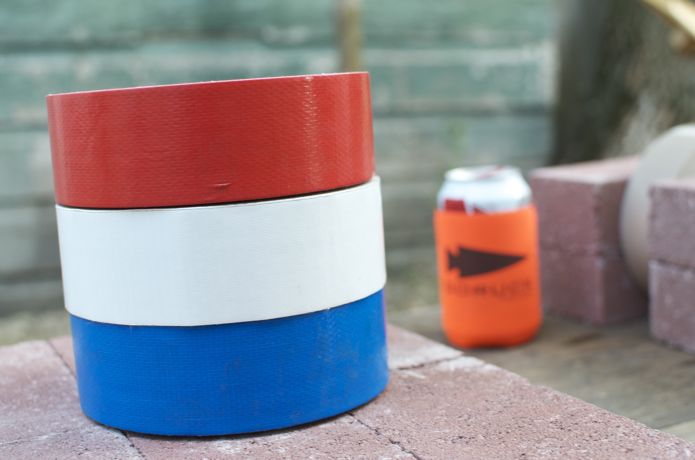
The military has all the best stuff. Equipment etc that costs too much if you had to pay for it. But lucky for military types Uncle Sugar has deep pockets to buy the best. And you get paid to use it in (sometimes) cool places, doing cool things with cool people. Weapons, vehicles, and (almost) all the gear you ever wanted. And even though everything is ‘mil-spec,’ you learn fast that you better take care of your gear. Because nothing is indestructible.
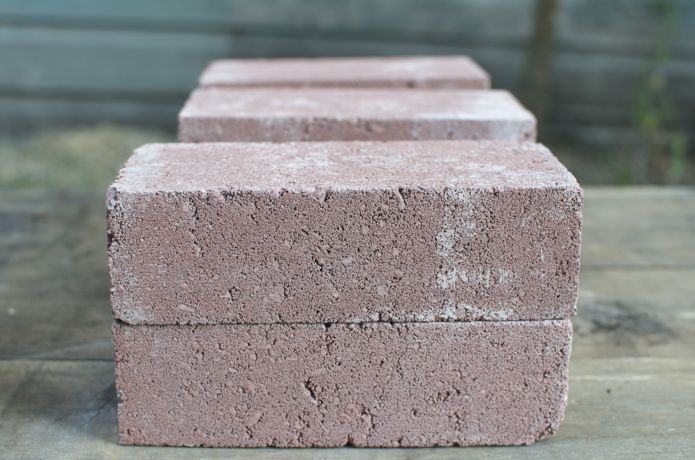
Bricks are required for the GORUCK Challenge, and back in the early days of the Challenge I found out from peoples’ smiles and a couple stickers I saw (got bricks?) that rucking with bricks is kind of our thing. But bricks are really, really abrasive so you have to wrap them up. The fabric and the zippers that we use in our rucksacks are the best on the market, period, but they won’t stop bullets. Or raw bricks shifting and moving around for 12 hours of the Challenge. You probably don’t want to earn the nickname Raw Dog, either. Trust me.

You’ll have 4 bricks if you weigh under 150 lbs, 6 bricks if you’re over 150. Occasionally, life tries to be fair. One of these Challenges, we’ll bring a scale out. Till then, like most of life, it’s the honor system. I recommend wrapping them in pairs. This lets you test out different ways to put them in your ruck – and it also lets you train in increments. More on the training stuff later. For this post, Chris (don’t call him Donnie he hates that) is wrapping sets of 2 bricks using red, white, and blue duct tape.
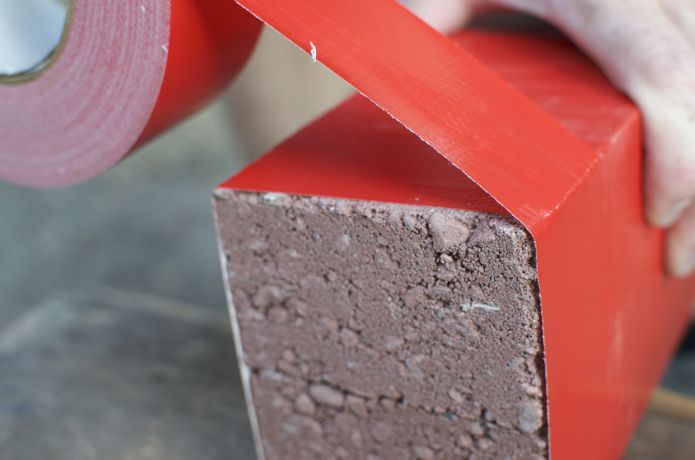
Red, White, and Blue were the only best three colors we could think to use. Every set of two bricks gets three layers of duct tape. Just start rolling the tape over the two bricks short ways (above), then tear it and do it long ways (below).
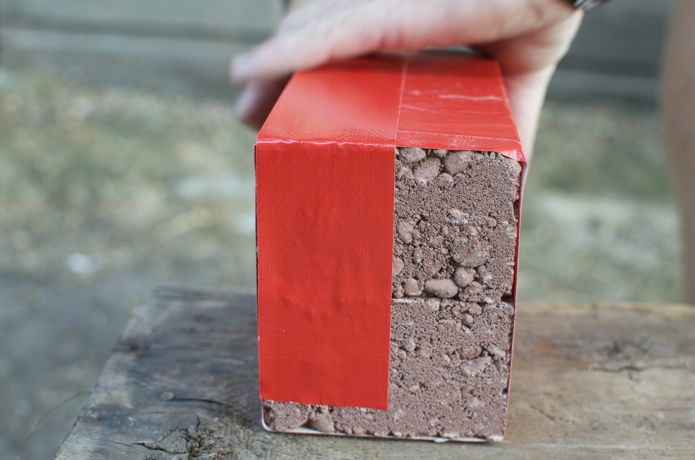
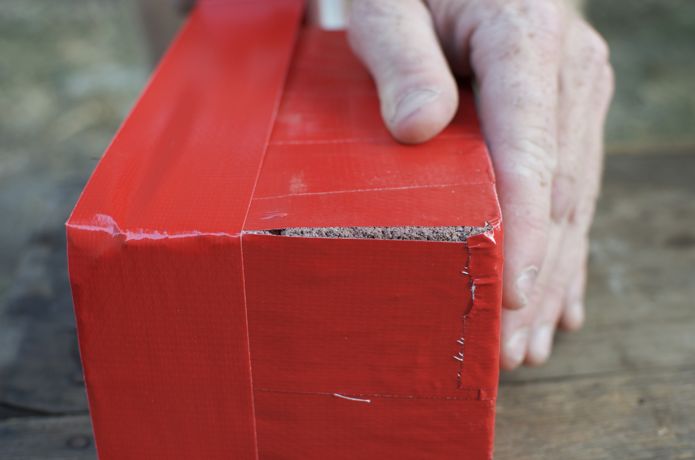
Above, make sure there is no exposed brick. Add enough wraps until you don’t see any.
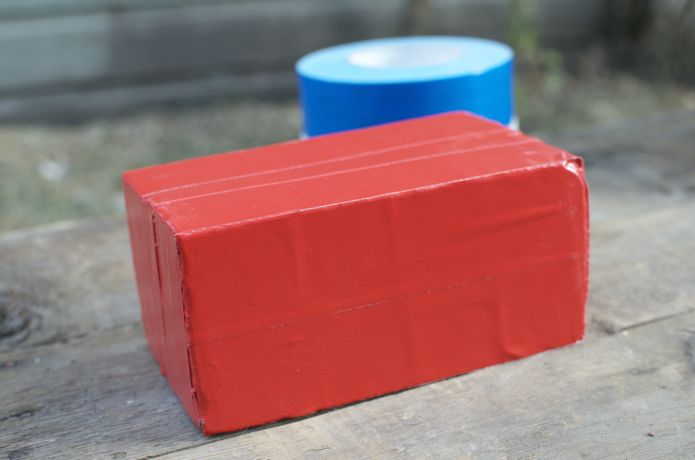
The first layer complete above, in red. The second layer is in white. It’s a repeat of what Chris don’t call him Donnie he hates that did in red. Naturally, you could do all three layers it in one color, but I thought doing three different colors would make it easier for people to follow. The people I’m talking about are my friends, who always tell me they hate reading what I write and just want to see pictures.
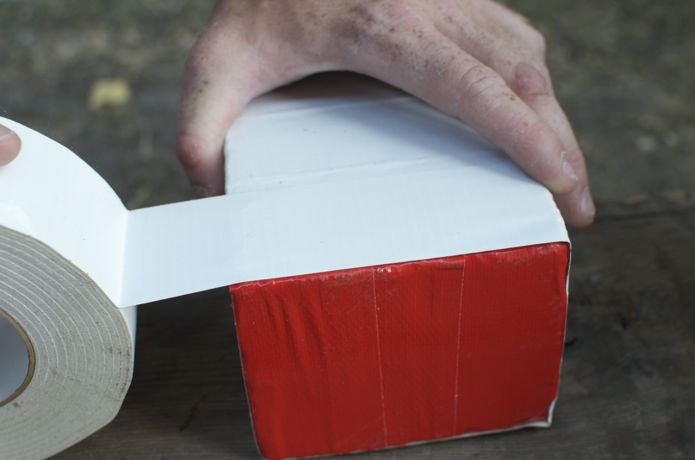
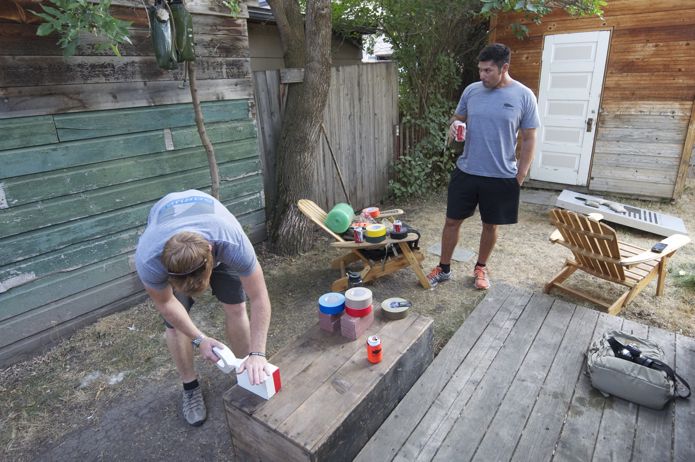
Here’s the random plug to have a good time prepping for the Challenge, including wrapping bricks. And if you’re hanging out, drinking beers with your buddies while you do it, experts abound when you’re not doing it perfectly. Chris don’t call him Donnie he hates that never could have done this alone without Lou there to drink beers I mean manage.
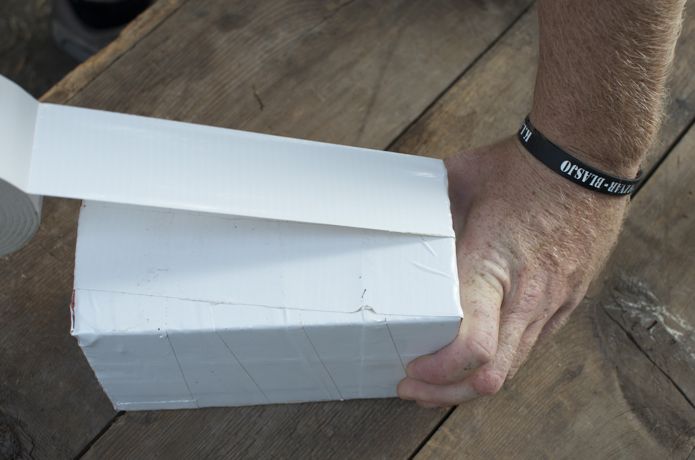
Second layer in white, almost complete above, then the third layer in blue, starting below.
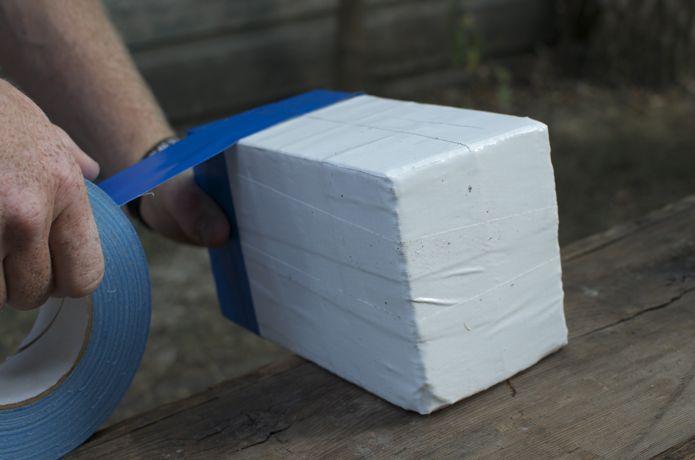
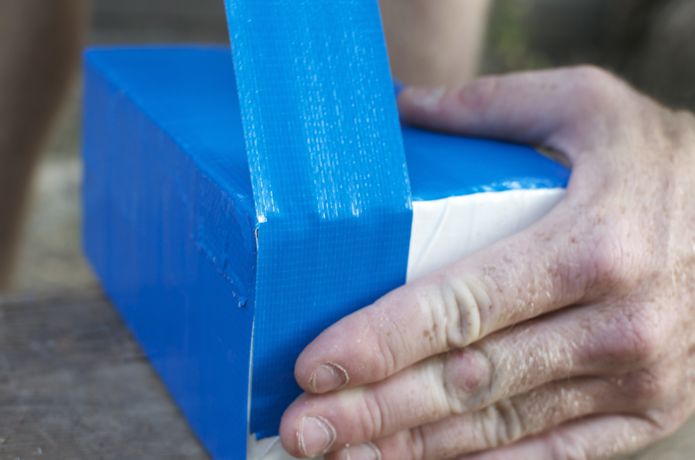
Above: the corners matter most, so make sure they’re covered up.
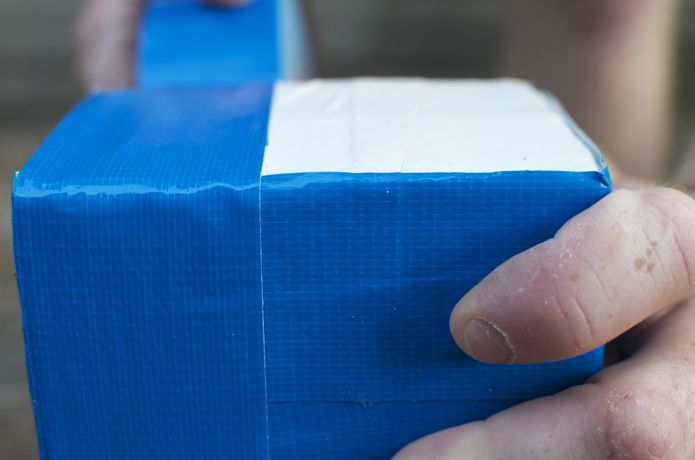
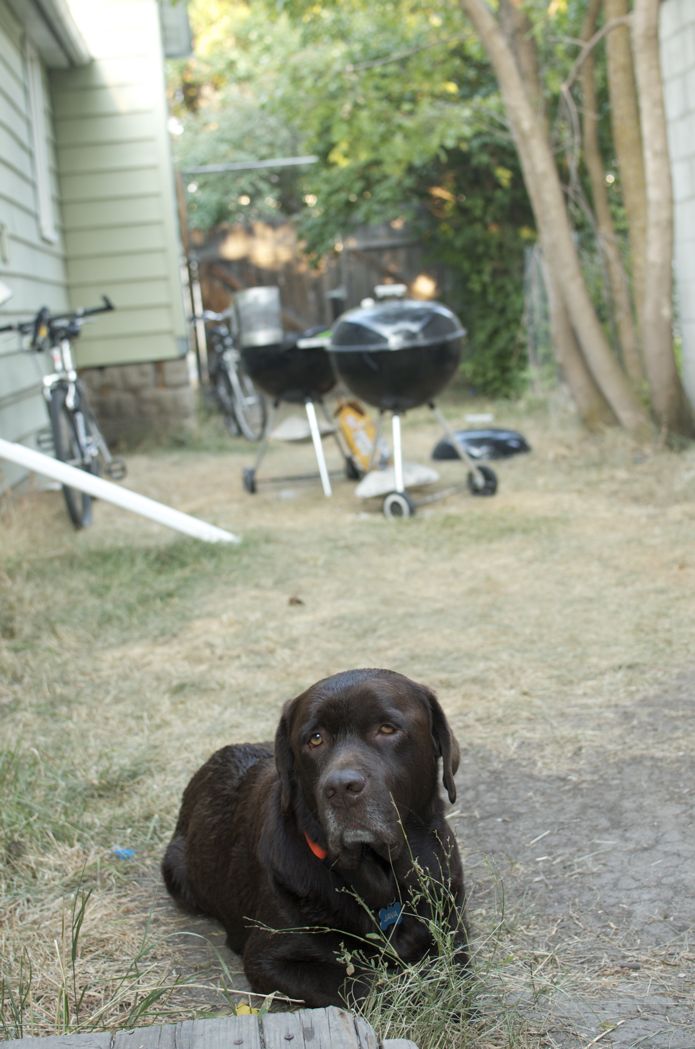
We take quality control very seriously. Pictured above is the big dog QC manager: part Adonis, part Ares. Less focused on beer like Lou and more on results. And get back to work Chris don’t call him Donnie he hates that.
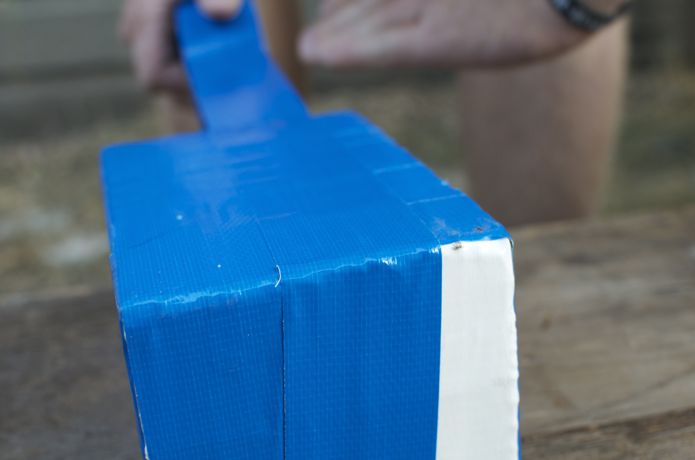
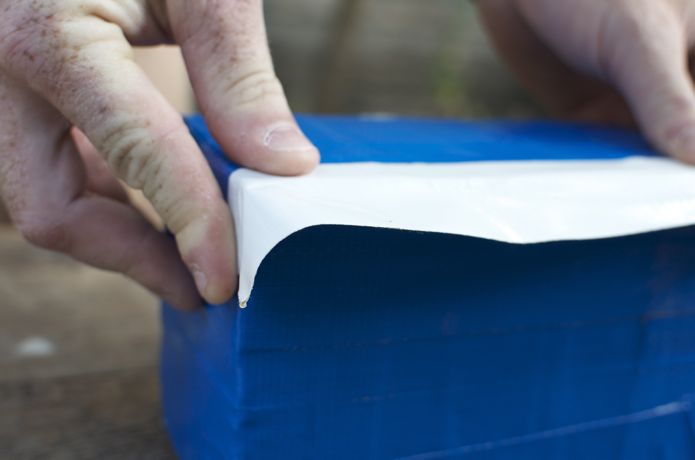
Once the third layer in blue is complete (above), you need to reinforce the corners. To make it easier to follow, Chris don’t call him Donnie he hates that is using a strip of white tape to reinforce the corners of the brick present.
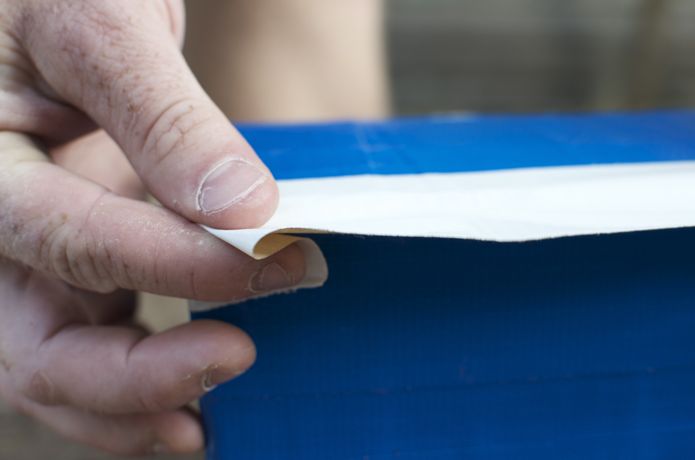
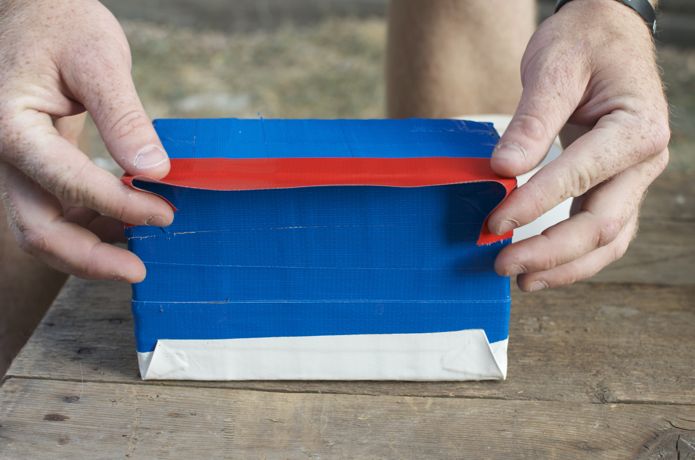
Above, each corner gets reinforced, the next strip of tape is red and you fold it down sort of like wrapping a present.
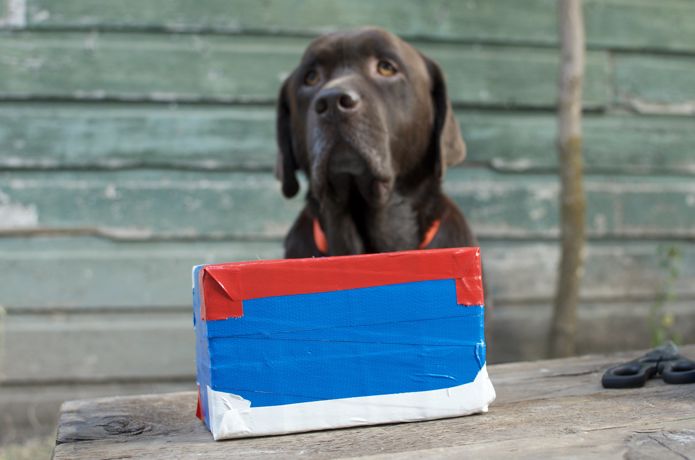
It doesn’t have to be perfect. But it does have to have 3 layers of duct tape, and in my opinion, if it’s got some red, some white, and some blue, it doesn’t get much sexier than that.
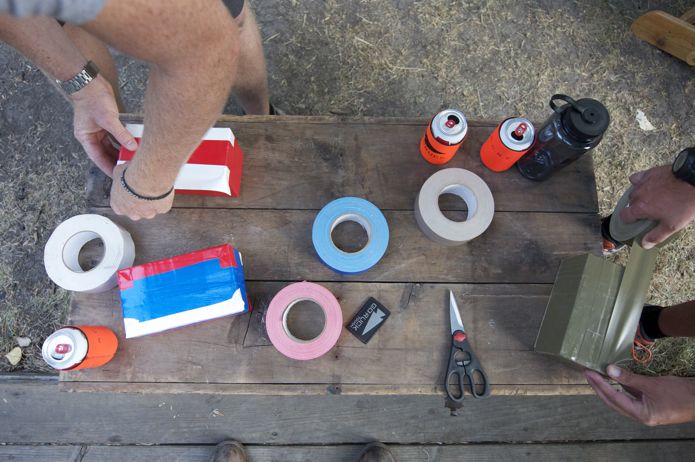
So, two more sets of bricks. Chris don’t call him Donnie he hates that on the left, Lou getting in on the action on the right after Java thugged him out for being lazy. So red, white, and blue are beautiful, but they also happen to go well with Army OD (olive drab) green. This tape (below) is known as 100 mph tape because it was thought that it could hold a Jeep together doing 100 mph. Then like most things, the name stuck and guys started calling it that. This is the tape you deploy with, the tape you trust for any problem tape can solve. It’s tough, sticky, and it lasts forever.
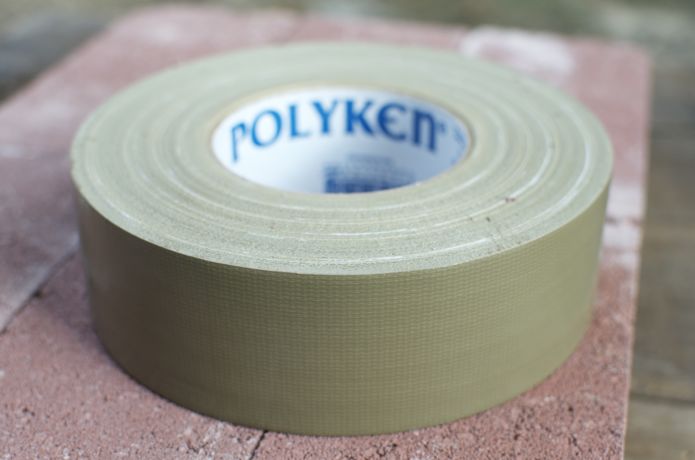
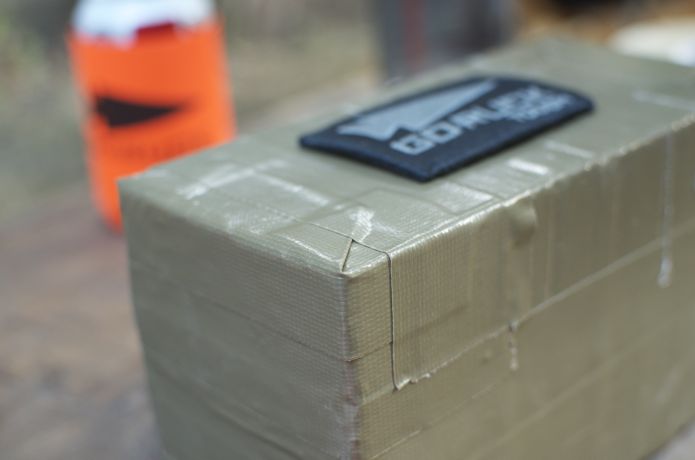
Lou has 4 great kids and, above, you can tell he wrapped a few presents in his day. Nice corners, good folds, reinforced. Well done. Now be less lazy next time and you won’t get thugged out.
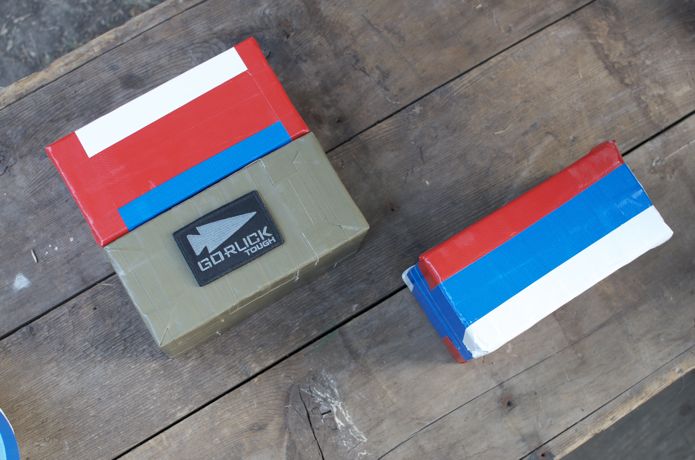
So the 6 bricks are all wrapped, three presents of 2 bricks each. I recommend training with a weighted ruck to prepare for the Challenge. But if you’ve never rucked with weight before, it’s something you should ease into. Start with your first present the first week and increase over time in preparation. Do not train for the Challenge by running with weight. Walk at a good pace but no running unless you want Army knees (trust me you don’t). When 2 bricks get easier, take it up a notch to 4 and then get to your full 6 bricks.
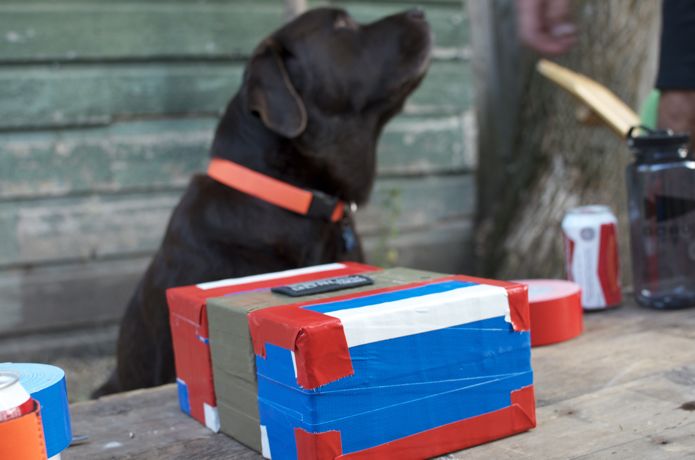
It’s important to train as you fight. You know you’re going to have weight on your back for the Challenge, so you need to train with weight on your back. Back in my Q-Course days, we had really long patrols — up to 4 days — with really heavy rucks, but I never had 4 straight days to train. So my thought was to train with a ruck that was heavier than my patrol pack would ever be. Bad for the body but good for the mind type stuff. I felt ready when it was go time because I had put the work in. I think the Challenge is kind of like this. You can always just gut through it, but if you feel ready, you’ll do better and give more to your team.
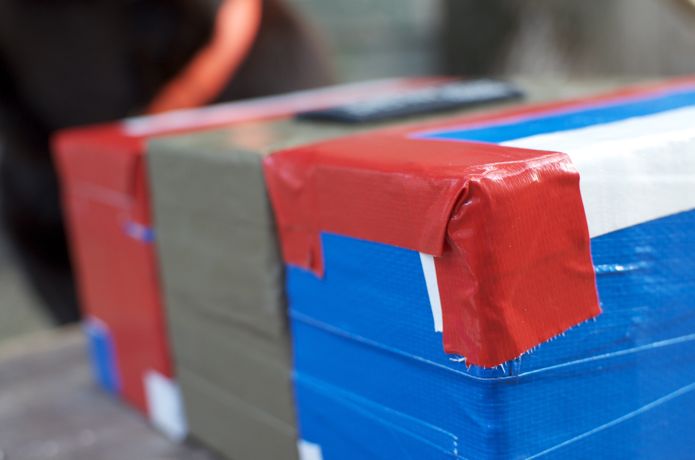
I’ve seen a lot of designs on brick wrapping over the years. Some guys have honored fallen buddies, others have honored kids with cancer, that kind of stuff. I’ve seen US Flag designs, stars and all, and I’ve seen all different colors of duct tape. You don’t have to do anything like this and your bricks don’t have to mean anything to you, but it’s kind of cool if they do. It adds a little more value to your full Challenge experience. Which by the way is about more than just you, and the more reminders of that, the better.

Chris don’t call him Donnie he hates that had to take the Challenge before he could become Cadre. His brick configuration in his GR1 was to put the three brick presents directly on top of each other, then secure them together with 100 mph tape. This reduces shifting around.
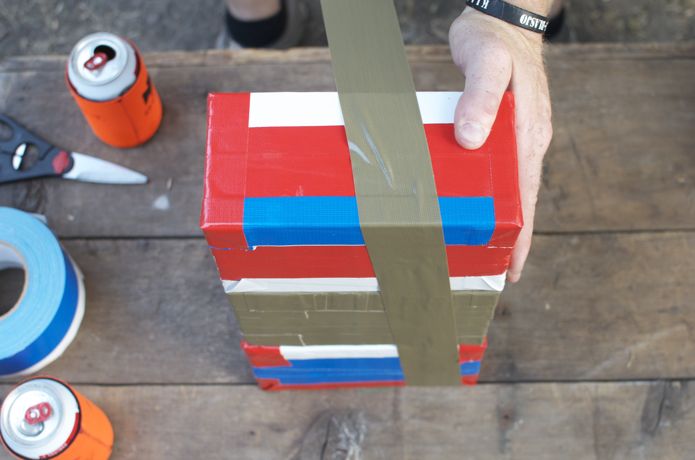
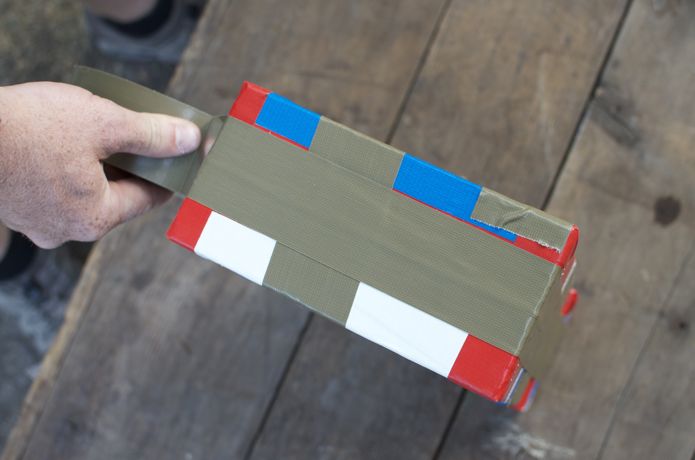

And don’t forget the sticker. Any sticker you like, of course. Chris don’t call him Donnie he hates that chose the GORUCK sticker because it was the only one lying around, but otherwise he probably would have picked some Special Forces war sticker or something. Maybe a machine gun or a grenade or some bullets. Man does he love talking about that stuff. Sort of like Bubba talking about shrimp in Forrest Gump.


Almost done, but for the Challenge we recommend bubble wrap in addition to the duct tape. It gives the big package less tendency to shift around and it’s additional protection. Sure, the duct tape, 3 layers of it will work just fine on its own, but what we’ve seen over time is that your bricks will sit better and shift around less with bubble wrap. You guessed it, 3 is the magic number of wraps.
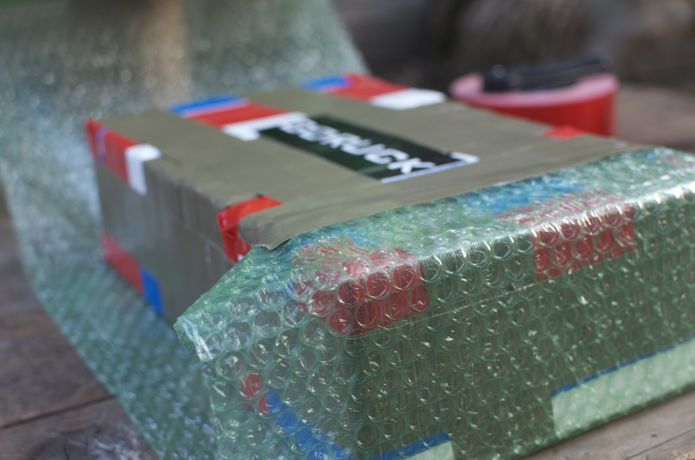
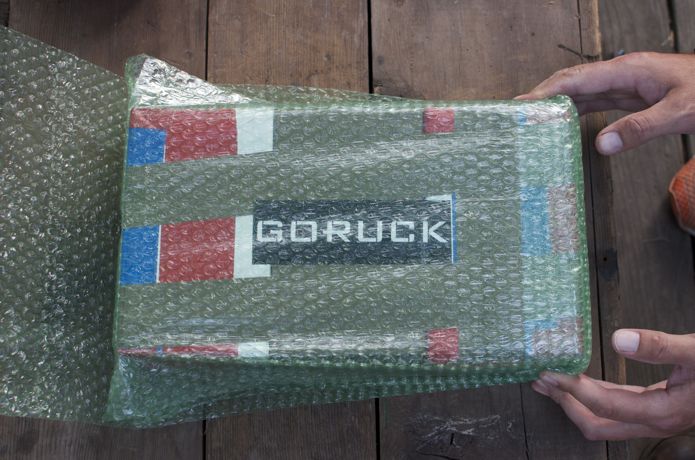

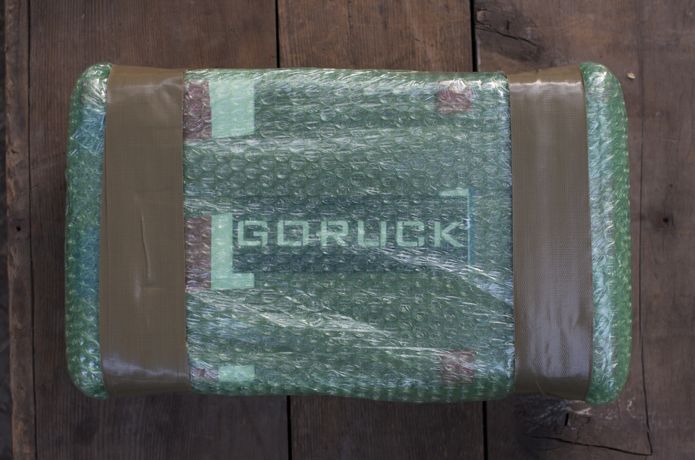
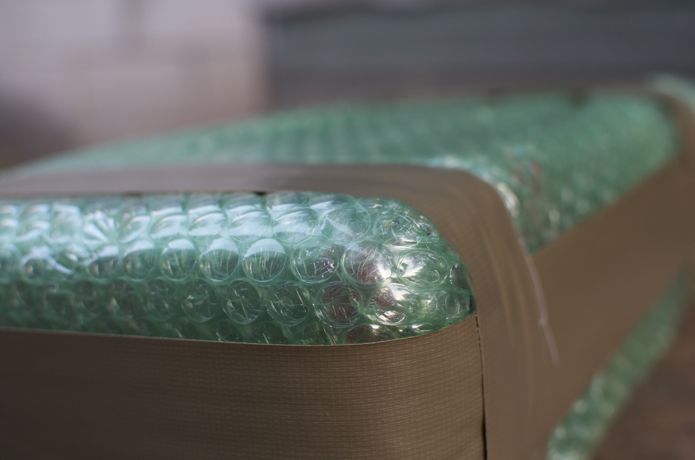
Ultimately, it’s your system. Your bricks, your ruck, and you gotta pack it how you like it. If you take anything away from this post, let it be this: test it out before you show up.
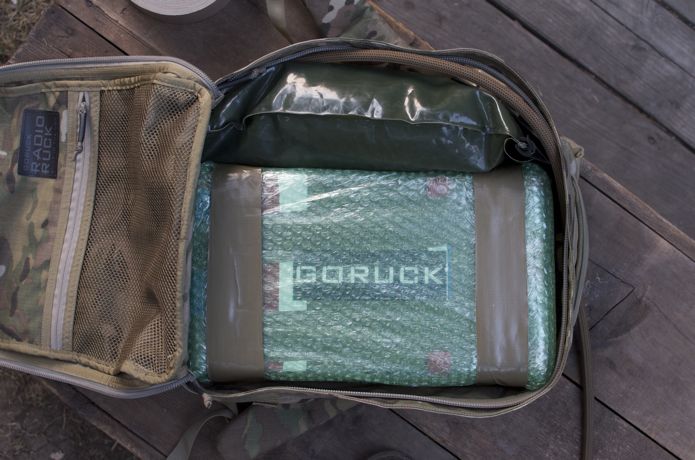
Above is a system for the Radio Ruck. Below is the GR1. Each has a Source hydration bladder and the 6 bricks in the main compartment. I recommend putting your bladder in the main compartment because it will lie flat against your back. Again, though, everyone’s bodies are different and you gotta see what works best for you.
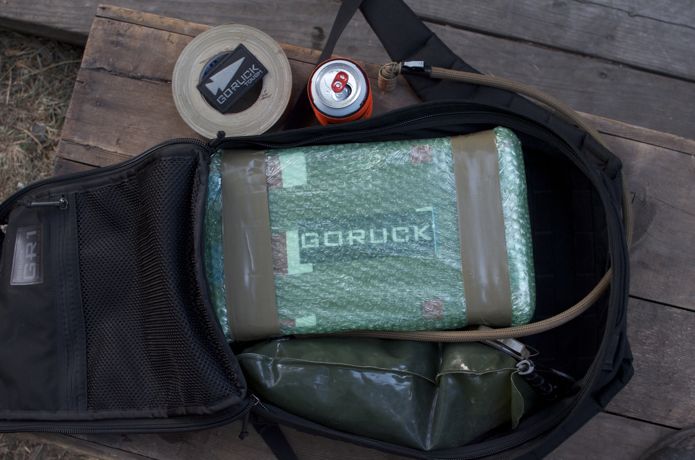
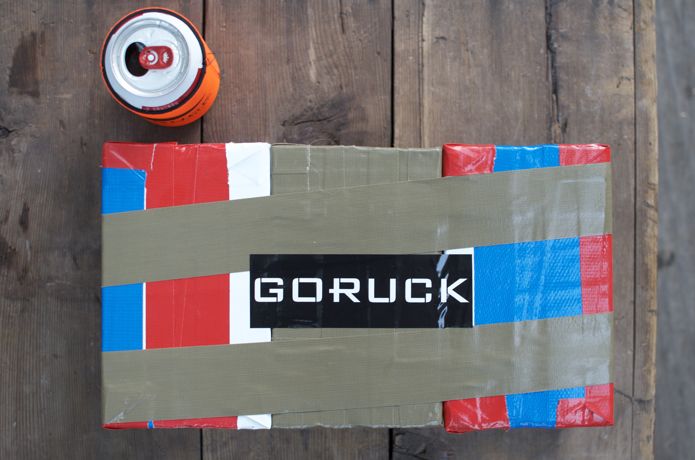
Sexy. I love red, white, and blue, with the Army green and the GORUCK sticker. And I had a blast doing this post from a backyard in Bozeman. Everything is fun when you’re in good company. As for the Challenge and bricks and stuff, embrace the suck and, like always, look cool doing it.
Since he hates being called Donnie, how about Tin Tin?
Things slow at GRHQ? A lot of effort went into a “How to duct tape your bricks for dummies” post.
Make sure you use lots of bubble wrap. Lots and lots of it. You never know if your bricks may speed toward a buddy’s head during buddycarries. Derp.
I think if Jason took pictures of paint drying and wrote a few paragraphs I would still read it twice. Keep them coming Jason.
I’ve been going with the train heavier than my ruck will ever be mentality too. Hope the 6 bricks feels light by the time I do the Challenge.
Great system, love the colors.
Nicely written, and always good to have more fuel on TinTin 😉
I have a different philosophy on training with bricks and wrapping them but I recognize that my philosophy is also slightly stupid. Now when people ask I can point them here for something much less stupid 🙂
Great post. Always good to get some inside info. I’d love to see what you guys think about brick selection.
Sweet, exactly how I set my bricks up (except that my wrapping has them look like gipsy bricks, you know). Also been doing the “go heavier now, it will feel lighter then” thingy. Nice post, keep’em coming!
Another quality post that makes it seem like every day in Bozeman is a good day.
Carrying the hydration bladder in the back compartment helped ease some of the stress on my head when we lost strap privileges, at least until I drank all of my water. A happy accident, since I didn’t consider that usage scenario when I packed my bag for the challenge.
Brick selection is easy. No holes in them, that’s where the cheating yourself begins. Other than that, they should be the size of a brick and weigh as much as a brick. 🙂
I went with the tape/bubble wrap/tape layering…2 sets of 3 bricks..made ’em look like i had some special “Columbian bricks” 🙂 Named them “Fear” and “Loathing”…good stuff.
Sooo dont call him Donnie? He hates that?
I wrote about bricks on our event page for the Berlin Challenge (http://www.facebook.com/events/195043907237001/)
It appears “they should be the size of a brick and weigh as much as a brick” isn’t a very good metric. I tried to fit 6 standard swedish bricks in my GR1 and could barely close it, let alone trust the pack to stand the load for very long (we’re talking 49.1 pounds of weight). German bricks are larger still than swedish ones. This seemed wrong (to the point of risky) so I just decided to check in on things.
At least, for the international challenges, I’d like to have a target weight instead of a set number of bricks. Not as a point of fairness, I just don’t want people to kill themselves or destroy rucks.
(Just to take overthinking things to the extreme, concrete “bricks” can have significantly higher density than the clay ones. Something to think about when choosing.)
Interesting point, DB. An American brick weighs 5 lbs, which is about 2.3 kilos. So, for 6 bricks let’s call it 13.8 kilos. Might as well call it 14 then. Have fun in Berlin, it’s a great city for a Challenge.
Just weighted my 6 bricks for Berlin challenge – 22.3 kilo. Do I carry this, then?
Just asking…
I went with concrete bricks–but I don’t think they weigh any more than clay.
Short answer, Filip, is no, that’s significantly heavier than our intent. We’ll post a policy for you all across the pond since the bricks weight so much more. Standby, and thanks for asking.
Great post! I will be using some Athens Block bricks from my hometown. They still pave some of the streets around southeast Ohio. They are quite old so I’m not sure if they weigh the same, but the dimensions are a bit larger than bricks you’d pick up at Lowe’s or Home Depot. It is a small price to pay to be packing a little sentimental piece of home during the challenge. I’ll check back in on the post when I weigh and measure all my presents. Keep up the good work!
Just wrapped my bricks. I wrapped them individually so I can add one brick at a time as training progresses. Lots of work to do before Chicago
Chris/Donnie is a hot ginger. I sort of fell in love with him reading while reading this article.
Please excuse the typo in the previous comment. I guess that just goes to show just how distracted I was by his good looks, right? 😉
I won’t tell him, Cameron. It’ll go straight to his head, which is the last thing he needs 🙂
haha alright then yeah, don’t tell him! Thanks for the article by the way – super excited for my first GoRuck Challenge in February!
So 6 bricks x 5 = 30 pounds…
2 x ESAPI plate = about 31 pounds…
About the same as two ESAPI plates. How does GORUCK feel about that as an option?
Very well done and easy to follow instructions. I’d like to share two suggestions based on my own experience. I suggest reinforcing the corners after the first layer of tape (red) but before the white and blue layers. My thinking is that this will offer more protection to the relatively smaller pieces of tape used for corner reinforcement. I do this after the red layer, though, because the red tape layer offers a better foundation for the corner reinforcement tapes than the brick itself. Secondly, I need to work up to the full 6 brick load more slowly and systematically than some GORUCKers. I got 8 total bricks and wrapped them in 3 sets of two bricks each and two single bricks.I then combined two of the 2 bricks into a 4 brick configuration before bubble wrapping each set. The resulting set of one 4-brick, one 2-brick, and two 1-bricks allows me to adjust the weight to be rucked in one brick increments from zero to 6, or even 8, total bricks.
Meant to type 5 x ESAPI plates is roughly equal to 30 lbs above, not 2.
So six bricks at roughly 5 lbs each is 30 lbs, 5 ESAPI plates could be another approach.
We are doing the challenge in Sydney in April. There has been some confusion about brick weights.
I have been training with three bricks – 17kg in total (37.5 pounds). That means 6 bricks would be over 60 pounds. Heavy! And also won’t fit in the ruck 😉
I saw Jason’s comment above where he says the average American brick weighs about 2.3kg, so I have been pointing other Aussie ruckers to this as a guide.
But I don’t want to be giving bad information. Maybe you could provide official advice for Australians?
This probably has been pointed out elsewhere, but the packing list says a brick should weigh 4-6 pounds.
Got my 6 bricks in a GR1 and there’s not much room for much else. Weight comes in at 14kg, which is about right. In NZ, which has the same building supply chain stores as Australia, the building centres tend to stock landscaping blocks and not building bricks. The difference in weight is significant. You may have to go to a brick supply company to get building bricks. On the positive side, the brick supply companies have websites where you can order a sample boxes of 3 bricks, delivered to your door for your next “building” project.
Jason,
“Bricks – four if you are under 150 pounds, six if you’re over. Life isn’t fair. Each brick should weigh 4-6 pounds.”
I went brick shopping and came across some pavers at Home Depot. They are solid, 1 3/4″ x 3 7/8″ x 7 3/4″ and weigh 4.2 pounds (4 lbs 3.2 ozs).
Would any of the cadre have an issue with a participant over 150 pounds using 6 of these “pavers” in the challenge?
John – no Cadre will fault you for that, it’s more about the spirit of it than the specifics. Have fun and train hard.
Looks pretty tough (not enough room) to strap in or secure the (6) bricks into the interior webbing holds of the GR1. (4) bricks – yes, (6) bricks – no. Either they can be supported by the “yoga” block to sit up higher or either they sit sown lower. Each has it’s pros/cons when carrying significant weight in a pack.
P.S. looking forward to probably being the oldest in upcoming GRC…
Win,
“…probably being the oldest in upcoming GRC…”
Care to share what challenge and what age?
I’ll be 59 at the Austin challenge on 5/4/13 starting at 22:00. 🙂
John,
You have me beat…am 47. GRC will be in Philly soon. Good luck…you’ll do great. Very inspiring…
Win,
I’m sure that you will “rock” the GRC at Philly as well. Should I have said “ruck” instead? 😉
“Pops”, me, will be doing the Austin GRC with his soon to be 29 year old son.
Good Livin’ 🙂
Perhaps GoRuck could start selling standard weight bricks as well as sandbags 😉
As George above pointed out, the guide is for bricks weighing 4-6 pounds. That’s fine in the States but, as I’ve found in Australia the bricks (in Melbourne at least) START at over 6 pounds. The ‘lightest’ ones I could get are 7 pounds a piece and its a struggle to get them to fit in a GR2.
19.8kg = 43 pounds, no ruck and nothing else.
There is a common Australian expression “built like a brick sh*thouse”, to describe someone who is built. I’m thinking carrying these 7 lb bricks is the way to get to such a physique. For reference, two weeks ago my 6 pack o’ New Zealand bricks was 16.7kg for the GRC there.
Matt – sandbags are in the very near future, and we’re working on the brick thing, which is tougher than you might believe. We’re on it, though – anything for you good folks Down Under. Who doesn’t love you guys? 🙂
Do you all have any stickers for sale? I’d like to put one on my jeep.
Brian – send us a note to info at goruck.com and we’ll hook you up. Thanks, man.
any advice for packing a GR-2?
Why would you package rubber covered dumbells – I even have some ankle weights? obviously not as rough on your equipment…
Based on the packing list, I went with sand bags weighing 6#. I followed the ITS tactical method of wrapping my ‘pills’ with 100 mph tape. Based on my size of 190#, I’ll be carrying 24# of sand in my pack.
Great read and even better pictures! In some ways glad I have a little over a month left before the GRC in Chicago, yet your posts are so enticing I wish it were sooner! 🙂
Do you still do the challenges? I’m not far from Athens and looking to do my first one in June in Columbus.
Our store provides a vast selection of certified healthcare solutions for different conditions.
This website ensures fast and safe shipping to your location.
Every item is supplied by licensed manufacturers for guaranteed effectiveness and reliability.
Easily search through our catalog and place your order hassle-free.
Need help? Customer service will guide you 24/7.
Take care of yourself with our trusted online pharmacy!
https://www.apsense.com/article/838695-the-final-revelation-what-is-cenforce-100-really.html
Что такое BlackSprut?
BlackSprut привлекает внимание разных сообществ. В чем его особенности?
Этот проект предоставляет широкие функции для аудитории. Оформление сайта отличается функциональностью, что делает его доступной без сложного обучения.
Необходимо помнить, что этот ресурс работает по своим принципам, которые делают его особенным на рынке.
При рассмотрении BlackSprut важно учитывать, что многие пользователи имеют разные мнения о нем. Некоторые подчеркивают его возможности, а кто-то оценивают его неоднозначно.
Подводя итоги, эта платформа продолжает быть темой дискуссий и привлекает интерес разных пользователей.
Обновленный сайт BlackSprut – здесь можно найти
Хотите найти актуальное ссылку на BlackSprut? Это можно сделать здесь.
https://bs2best
Периодически платформа меняет адрес, и тогда приходится искать новое зеркало.
Мы мониторим за актуальными доменами и готовы поделиться новым линком.
Посмотрите рабочую ссылку прямо сейчас!
На нашем портале вам предоставляется возможность наслаждаться большим выбором игровых автоматов.
Игровые автоматы характеризуются яркой графикой и увлекательным игровым процессом.
Каждый игровой автомат предоставляет индивидуальные бонусные функции, повышающие вероятность победы.
1xbet игровые автоматы
Слоты созданы для любителей азартных игр всех мастей.
Можно опробовать игру без ставки, после чего начать играть на реальные деньги.
Испытайте удачу и насладитесь неповторимой атмосферой игровых автоматов.
На этом сайте вы можете наслаждаться широким ассортиментом игровых слотов.
Игровые автоматы характеризуются яркой графикой и интерактивным игровым процессом.
Каждый слот предлагает особые бонусные возможности, улучшающие шансы на успех.
1xbet казино
Игра в игровые автоматы предназначена игроков всех уровней.
Есть возможность воспользоваться демо-режимом, а затем перейти к игре на реальные деньги.
Проверьте свою удачу и получите удовольствие от яркого мира слотов.
На нашем портале вам предоставляется возможность наслаждаться широким ассортиментом игровых слотов.
Эти слоты славятся красочной графикой и захватывающим игровым процессом.
Каждый игровой автомат предоставляет особые бонусные возможности, увеличивающие шансы на выигрыш.
1win casino
Слоты созданы для игроков всех уровней.
Можно опробовать игру без ставки, и потом испытать азарт игры на реальные ставки.
Испытайте удачу и насладитесь неповторимой атмосферой игровых автоматов.
Our platform features a wide selection of slot games, designed for both beginners and experienced users.
On this site, you can explore classic slots, modern video slots, and jackpot slots with stunning graphics and dynamic music.
Whether you’re into simple gameplay or prefer bonus-rich rounds, you’ll find what you’re looking for.
https://big-daddy-design.com/wp-content/pgs/?tovary_dlya_turizma.html
Each title can be accessed 24/7, with no installation, and perfectly tuned for both all devices.
Besides slots, the site includes helpful reviews, bonuses, and player feedback to guide your play.
Register today, start playing, and have fun with the excitement of spinning!
На этом сайте вы сможете найти интересные игровые слоты в казино Champion.
Ассортимент игр включает проверенные временем слоты и новейшие видеослоты с качественной анимацией и разнообразными функциями.
Любая игра разработан для максимального удовольствия как на десктопе, так и на мобильных устройствах.
Будь вы новичком или профи, здесь вы обязательно подберёте слот по душе.
скачать приложение
Автоматы доступны без ограничений и не нуждаются в установке.
Также сайт предусматривает бонусы и рекомендации, чтобы сделать игру ещё интереснее.
Попробуйте прямо сейчас и насладитесь азартом с играми от Champion!
На данной платформе доступны онлайн-игры от казино Vavada.
Любой игрок может подобрать автомат по интересам — от традиционных игр до современных слотов с яркой графикой.
Платформа Vavada открывает доступ к популярных игр, включая слоты с крупными выигрышами.
Любой автомат доступен в любое время и подходит как для компьютеров, так и для мобильных устройств.
вавада зеркало сегодня
Игроки могут наслаждаться азартом, не выходя из квартиры.
Интерфейс сайта проста, что обеспечивает без труда начать играть.
Зарегистрируйтесь уже сегодня, чтобы погрузиться в мир выигрышей!
On this platform, you can find a wide selection of online slots from famous studios.
Users can try out retro-style games as well as feature-packed games with vivid animation and interactive gameplay.
Whether you’re a beginner or a seasoned gamer, there’s a game that fits your style.
casino games
Each title are ready to play 24/7 and optimized for laptops and mobile devices alike.
No download is required, so you can jump into the action right away.
The interface is user-friendly, making it quick to find your favorite slot.
Sign up today, and discover the thrill of casino games!
Сайт BlackSprut — это хорошо известная онлайн-площадок в darknet-среде, предлагающая разнообразные сервисы в рамках сообщества.
В этом пространстве предусмотрена понятная система, а визуальная часть понятен даже новичкам.
Участники выделяют стабильность работы и жизнь на площадке.
bs2 best
BlackSprut ориентирован на комфорт и безопасность при навигации.
Тех, кто изучает инфраструктуру darknet, BlackSprut может стать интересным вариантом.
Перед началом не лишним будет прочитать основы сетевой безопасности.
Предстоящее лето обещает быть ярким и оригинальным в плане моды.
В тренде будут натуральные ткани и минимализм с изюминкой.
Актуальные тона включают в себя мягкие пастели, сочетающиеся с любым стилем.
Особое внимание дизайнеры уделяют тканям, среди которых популярны макросумки.
https://fb.elfnon.com/post/766_lepodium-%D0%BB%D1%8E%D0%BA%D1%81-%D0%B1%D1%80%D0%B5%D0%BD%D0%B4%D1%8B-%D1%81-%D0%B4%D0%BE%D1%81%D1%82%D0%B0%D0%B2%D0%BA%D0%BE%D0%B9-%D0%BF%D0%BE-%D1%80%D0%BE%D1%81%D1%81%D0%B8%D0%B8-%D0%BD%D0%B5%D1%81%D0%BC%D0%BE%D1%82%D1%8
Снова популярны элементы модерна, в современной обработке.
На улицах мегаполисов уже можно увидеть трендовые образы, которые вдохновляют.
Будьте в курсе, чтобы создать свой образ.
Here offers a wide selection of interior timepieces for all styles.
You can browse modern and traditional styles to enhance your living space.
Each piece is curated for its design quality and functionality.
Whether you’re decorating a creative workspace, there’s always a perfect clock waiting for you.
compass rosewood desktop clocks
Our assortment is regularly expanded with trending items.
We focus on quality packaging, so your order is always in trusted service.
Start your journey to enhanced interiors with just a few clicks.
This website offers a great variety of home wall-mounted clocks for every room.
You can explore modern and timeless styles to complement your apartment.
Each piece is carefully selected for its craftsmanship and functionality.
Whether you’re decorating a stylish living room, there’s always a fitting clock waiting for you.
best vintage brass desk clocks
Our assortment is regularly renewed with trending items.
We care about customer satisfaction, so your order is always in good care.
Start your journey to better decor with just a few clicks.
This website offers a diverse range of interior wall clocks for every room.
You can browse modern and vintage styles to fit your interior.
Each piece is carefully selected for its design quality and accuracy.
Whether you’re decorating a stylish living room, there’s always a beautiful clock waiting for you.
infinity instruments skyscraper xxl wall clocks
Our catalog is regularly expanded with fresh designs.
We focus on customer satisfaction, so your order is always in safe hands.
Start your journey to enhanced interiors with just a few clicks.
Here offers a wide selection of home wall clocks for all styles.
You can check out modern and traditional styles to fit your living space.
Each piece is curated for its aesthetic value and reliable performance.
Whether you’re decorating a functional kitchen, there’s always a beautiful clock waiting for you.
classic mantel clocks
The collection is regularly updated with fresh designs.
We prioritize secure delivery, so your order is always in safe hands.
Start your journey to timeless elegance with just a few clicks.
This online store offers a great variety of home wall clocks for all styles.
You can browse minimalist and traditional styles to complement your living space.
Each piece is hand-picked for its aesthetic value and accuracy.
Whether you’re decorating a stylish living room, there’s always a beautiful clock waiting for you.
sniders led neon sign wall clocks
The collection is regularly refreshed with trending items.
We care about customer satisfaction, so your order is always in good care.
Start your journey to better decor with just a few clicks.
Этот сайт — интернет-представительство лицензированного детективного агентства.
Мы предоставляем сопровождение в решении деликатных ситуаций.
Штат сотрудников работает с предельной осторожностью.
Мы занимаемся проверку фактов и выявление рисков.
Услуги детектива
Любой запрос обрабатывается персонально.
Применяем новейшие технологии и соблюдаем юридические нормы.
Нуждаетесь в настоящих профессионалов — вы нашли нужный сайт.
The site offers a wide range of medications for home delivery.
You can conveniently access treatments from anywhere.
Our inventory includes popular treatments and custom orders.
The full range is sourced from reliable providers.
https://members2.boardhost.com/businessbooks6/msg/1728473219.html
We maintain customer safety, with encrypted transactions and prompt delivery.
Whether you’re treating a cold, you’ll find safe products here.
Begin shopping today and get convenient online pharmacy service.
Данный ресурс создан для нахождения вакансий в Украине.
Здесь вы найдете разные объявления от разных организаций.
На платформе появляются предложения в разных отраслях.
Частичная занятость — решаете сами.
https://my-articles-online.com/
Сервис удобен и рассчитан на всех пользователей.
Начало работы не потребует усилий.
Хотите сменить сферу? — начните прямо сейчас.
It’s alarming to realize that nearly 50% of medication users experience serious pharmaceutical mishaps stemming from poor understanding?
Your health should be your top priority. Each pharmaceutical choice you consider significantly affects your long-term wellbeing. Staying educated about the drugs you take is absolutely essential for disease prevention.
Your health depends on more than swallowing medications. Each drug interacts with your physiology in potentially dangerous ways.
Remember these critical facts:
1. Taking incompatible prescriptions can cause health emergencies
2. Seemingly harmless allergy medicines have serious risks
3. Altering dosages undermines therapy
For your safety, always:
✓ Verify interactions via medical databases
✓ Review guidelines completely before taking any medication
✓ Speak with specialists about correct dosage
___________________________________
For verified pharmaceutical advice, visit:
https://my.archdaily.com/us/@cenforce-for-stronger-erections-better-performance-and-improved-stamina
Here, you can find a wide selection of casino slots from top providers.
Players can try out retro-style games as well as new-generation slots with high-quality visuals and interactive gameplay.
Even if you’re new or an experienced player, there’s a game that fits your style.
money casino
The games are available 24/7 and optimized for PCs and tablets alike.
You don’t need to install anything, so you can get started without hassle.
Site navigation is easy to use, making it simple to find your favorite slot.
Join the fun, and enjoy the excitement of spinning reels!
Our platform provides buggy rentals across the island.
Anyone can easily arrange a machine for fun.
When you’re looking to discover mountain roads, a buggy is the exciting way to do it.
https://www.zillow.com/profile/buggycrete
All vehicles are ready to go and offered with flexible schedules.
On this platform is user-friendly and comes with affordable prices.
Get ready to ride and experience Crete on your own terms.
This section presents CD player radio alarm clocks by top providers.
Browse through sleek CD units with FM/AM reception and two alarm settings.
These devices include AUX jacks, USB ports, and power outage protection.
Our range covers value picks to luxury editions.
radio with cd player and alarm clock
Each one offer snooze buttons, auto-off timers, and digital displays.
Order today via direct Amazon and no extra cost.
Discover the best disc player alarm clock for office everyday enjoyment.
This website, you can access a great variety of online slots from famous studios.
Visitors can enjoy traditional machines as well as feature-packed games with vivid animation and exciting features.
If you’re just starting out or an experienced player, there’s always a slot to match your mood.
casino games
The games are available anytime and designed for laptops and smartphones alike.
No download is required, so you can get started without hassle.
Site navigation is intuitive, making it quick to browse the collection.
Sign up today, and dive into the excitement of spinning reels!
Оформление страховки для заграничной поездки — это важный шаг для финансовой защиты отдыхающего.
Полис покрывает медицинскую помощь в случае травмы за границей.
Помимо этого, документ может включать компенсацию на транспортировку.
icforce.ru
Некоторые государства обязывают предъявление страховки для въезда.
Без страховки лечение могут быть финансово обременительными.
Приобретение документа перед выездом
Questo sito permette l’assunzione di lavoratori per incarichi rischiosi.
Gli utenti possono ingaggiare esperti affidabili per operazioni isolate.
Le persone disponibili sono valutati secondo criteri di sicurezza.
ordina omicidio
Con il nostro aiuto è possibile leggere recensioni prima di assumere.
La fiducia è la nostra priorità.
Contattateci oggi stesso per trovare il supporto necessario!
Этот сайт — подтверждённый онлайн-площадка Bottega Veneta с отгрузкой по РФ.
Через наш портал вы можете купить брендовые изделия Bottega Veneta напрямую.
Все товары идут с официальной гарантией от бренда.
духи bottega veneta
Перевозка осуществляется в кратчайшие сроки в по всей территории России.
Интернет-магазин предлагает выгодные условия покупки и комфортные условия возврата.
Доверьтесь официальном сайте Боттега Венета, чтобы быть уверенным в качестве!
Here, you can explore different platforms for CS:GO gambling.
We feature a wide range of wagering platforms focused on CS:GO.
Every website is thoroughly reviewed to provide trustworthiness.
esports cs go betting
Whether you’re new to betting, you’ll easily select a platform that matches your preferences.
Our goal is to guide you to access the top-rated CS:GO betting sites.
Check out our list right away and upgrade your CS:GO gambling experience!
В данном ресурсе вы сможете найти всю информацию о партнёрском предложении: 1win партнерская программа.
Доступны все особенности работы, условия участия и ожидаемые выплаты.
Любой блок детально описан, что делает доступным понять в особенностях процесса.
Также доступны FAQ по теме и полезные советы для новых участников.
Данные актуализируются, поэтому вы смело полагаться в достоверности предоставленных данных.
Данный сайт окажет поддержку в понимании партнёрской программы 1Win.
Here, you can browse top CS:GO betting sites.
We have collected a wide range of betting platforms centered around CS:GO.
These betting options is carefully selected to ensure fair play.
cs2 gambling
Whether you’re a seasoned bettor, you’ll effortlessly select a platform that meets your expectations.
Our goal is to assist you to enjoy reliable CS:GO wagering platforms.
Explore our list at your convenience and upgrade your CS:GO gambling experience!
¡Hola seguidores del casino !
ВїQuieres jugar sin pagar? Los spins gratis sin depГіsito estГЎn disponibles para nuevos registros en varios casinos online. Elige tu favorito y empieza.
100 gratis spins para usuarios de EspaГ±a sin depГіsito – 100 euros gratis sin deposito.
¡Que tengas magníficas rondas inolvidables !
?Hola cazadores de suerte
En 100girosgratissindepositoespana.guru siempre encuentras las promociones mГЎs nuevas y fiables. [url=п»їhttps://100girosgratissindepositoespana.guru/]100 giros gratis sin depГіsito[/url] Todo estГЎ diseГ±ado para que empieces sin inversiГіn. ВЎIdeal para jugadores nuevos!
ObtГ©n giros gratis sin depГіsito EspaГ±a para tragamonedas populares. Solo crea tu cuenta y disfruta al instante. ВЎNada que perder!
Visita 100girosgratissindepositoespana.guru y gana sin pagar – 100girosgratissindepositoespana.guru/#.
?Que tengas excelentes juegos !
Our service allows you to get in touch with professionals for occasional high-risk tasks.
Visitors are able to quickly request services for specialized operations.
Each professional are qualified in managing critical activities.
assassin for hire
The website guarantees secure connections between requesters and contractors.
Whether you need fast support, our service is ready to help.
Create a job and match with a skilled worker today!
Il nostro servizio offre l’ingaggio di lavoratori per incarichi rischiosi.
Gli interessati possono scegliere esperti affidabili per operazioni isolate.
Le persone disponibili sono selezionati con severi controlli.
ordina omicidio l’uccisione
Utilizzando il servizio è possibile ottenere informazioni dettagliate prima della selezione.
La sicurezza rimane al centro del nostro servizio.
Iniziate la ricerca oggi stesso per trovare il supporto necessario!
Searching to hire reliable contractors available to handle temporary hazardous assignments.
Need a specialist to complete a hazardous task? Discover trusted experts on our platform to manage critical dangerous operations.
github.com/gallars/hireahitman
This website connects clients with skilled professionals willing to accept high-stakes short-term gigs.
Employ pre-screened laborers to perform risky duties efficiently. Ideal when you need urgent situations demanding safety-focused labor.
Here, you can find a wide selection of online slots from leading developers.
Visitors can enjoy classic slots as well as new-generation slots with stunning graphics and interactive gameplay.
If you’re just starting out or an experienced player, there’s always a slot to match your mood.
play casino
The games are available anytime and designed for laptops and mobile devices alike.
No download is required, so you can get started without hassle.
The interface is user-friendly, making it quick to find your favorite slot.
Join the fun, and dive into the excitement of spinning reels!
Write more, thats all I have to say. Literally, it seems as though you relied on the video
to make your point. You definitely know what youre talking about,
why throw away your intelligence on just posting videos to your weblog
when you could be giving us something informative to read?
my web blog … nordvpn coupons inspiresensation
Hello, the whole thing is going perfectly here and ofcourse every one is sharing information, that’s really excellent,
keep up writing.
Feel free to surf to my page: nordvpn coupons inspiresensation (https://t.co/cFbWYj3h3m)
Looking for a person to take on a single risky task?
This platform specializes in connecting customers with contractors who are ready to execute critical jobs.
If you’re handling urgent repairs, unsafe cleanups, or complex installations, you’ve come to the perfect place.
Every available professional is vetted and certified to guarantee your security.
hire an assassin
This service offer transparent pricing, comprehensive profiles, and safe payment methods.
Regardless of how difficult the scenario, our network has the skills to get it done.
Start your quest today and locate the perfect candidate for your needs.
This website contains practical guidance about ways of becoming a system cracker.
Data is shared in a straightforward and coherent manner.
One can grasp a range of skills for penetrating networks.
Moreover, there are specific samples that manifest how to execute these competencies.
how to learn hacking
Complete data is frequently refreshed to remain relevant to the modern innovations in hacking techniques.
Unique consideration is focused on practical application of the gained expertise.
Bear in mind that each maneuver should be executed responsibly and according to proper guidelines only.
Our website are presented unique discount codes for 1xBet.
Such codes make it possible to acquire supplementary incentives when placing bets on the platform.
All existing promo deals are frequently checked to assure their relevance.
Using these promocodes it allows to significantly increase your potential winnings on the online service.
https://madrasahtbs.sch.id/pages/itogi_kino_2010_1.html
Besides, comprehensive manuals on how to redeem bonus codes are provided for better understanding.
Be aware that particular bonuses may have limited validity, so examine rules before redeeming.
This site you can discover exclusive discount codes for one of the leading betting services.
The variety of promotional offers is persistently enhanced to assure that you always have reach to the up-to-date opportunities.
By applying these discounts, you can economize considerably on your gambling ventures and multiply your options of accomplishment.
Each bonus code are meticulously examined for genuineness and efficiency before appearing on the site.
https://chhapai.com/pgs/legendarnyy_material_dlya_chistovoy_otdelki.html
Plus, we give extensive details on how to activate each enticing proposal to amplify your incentives.
Remember that some opportunities may have certain requirements or limited availability, so it’s critical to inspect diligently all the particulars before activating them.
¡Hola estrategas de las apuestas!
Con un bono sin depГіsito, no pierdes nada y puedes ganar mucho.
Este bono es perfecto para nuevos jugadores. [url=п»їhttps://25girosgratissindeposito.xyz/]25girosgratissindeposito.xyz[/url] Solo por unirse, obtienes 25 giros gratis.
¡Que tengas magníficas partidas exitosas !
Hello to our platform, where you can access exclusive materials created exclusively for adults.
The entire collection available here is appropriate for individuals who are of legal age.
Please confirm that you meet the age requirement before continuing.
big cock
Enjoy a unique selection of age-restricted materials, and immerse yourself today!
Here you can discover relevant knowledge about the path to becoming a security expert.
Facts are conveyed in a simple and understandable manner.
You’ll discover various techniques for bypassing protection.
Furthermore, there are working models that exhibit how to apply these capabilities.
how to become a hacker
Complete data is continuously improved to match the current breakthroughs in IT defense.
Unique consideration is paid to workable execution of the developed competencies.
Be aware that all operations should be executed responsibly and in a responsible way only.
The site makes available many types of prescription drugs for online purchase.
You can easily order essential medicines from anywhere.
Our catalog includes standard solutions and more specific prescriptions.
All products is supplied through licensed suppliers.
cenforce d
We maintain user protection, with encrypted transactions and timely service.
Whether you’re managing a chronic condition, you’ll find what you need here.
Visit the store today and experience trusted support.
350fairfax nordvpn promo code
My spouse and I absolutely love your blog and find nearly all of your post’s to be precisely what I’m looking for.
can you offer guest writers to write content in your case?
I wouldn’t mind writing a post or elaborating on a number of the subjects
you write regarding here. Again, awesome web log!
Thank you for sharing your personal experience and wisdom with us Your words are so encouraging and uplifting
¡Hola, entusiastas del entretenimiento !
Esta promociГіn es ideal para aquellos que estГЎn comenzando a jugar.
Los 10 euros gratis sin depГіsito son ideales para quienes desean jugar sin compromiso. Puedes usarlos para probar nuevas estrategias o descubrir juegos que no conocГas. AdemГЎs, te permiten disfrutar del casino sin presiГіn financiera.
Solo por registrarte: 10 euros gratis para jugar en casino – http://www.youtube.com/watch?v=DvFWSMyjao4
¡Que tengas excelentes triunfos !
One X Bet is a top-tier sports betting service.
Featuring a wide range of matches, 1xBet meets the needs of millions around the world.
The 1xBet app created for both Android as well as Apple devices players.
https://amsat-global.com/blog/pgs/pod_maskoy_2015_opisanie.html
Players are able to get the 1xBet app from the official website and also Google Play Store on Android devices.
iPhone customers, the app can be downloaded from the App Store easily.
The site offers a large selection of prescription drugs for home delivery.
Customers are able to securely access essential medicines with just a few clicks.
Our catalog includes popular medications and more specific prescriptions.
Each item is provided by verified suppliers.
super tadapox
We maintain customer safety, with data protection and on-time dispatch.
Whether you’re filling a prescription, you’ll find trusted options here.
Explore our selection today and experience stress-free online pharmacy service.
One X Bet Promotional Code – Vip Bonus as much as $130
Apply the One X Bet promo code: 1XBRO200 when registering on the app to access exclusive rewards provided by 1XBet for a 130 Euros maximum of 100%, for wagering along with a casino bonus including 150 free spins. Launch the app then continue with the registration process.
The One X Bet promo code: Code 1XBRO200 provides an amazing welcome bonus for new users — a complete hundred percent maximum of 130 Euros upon registration. Promo codes act as the key to unlocking rewards, plus 1XBet’s promotional codes are no exception. When applying this code, bettors can take advantage from multiple deals at different stages of their betting experience. Although you aren’t entitled for the welcome bonus, 1XBet India ensures its loyal users receive gifts via ongoing deals. Look at the Deals tab via their platform often to keep informed about current deals designed for loyal customers.
1xbet bonus promo code
Which One X Bet promotional code is presently available at this moment?
The bonus code applicable to One X Bet is Code 1XBRO200, which allows novice players signing up with the betting service to unlock a reward worth $130. For gaining exclusive bonuses pertaining to gaming and sports betting, kindly enter our bonus code for 1XBET while filling out the form. To make use from this deal, future players need to type the bonus code Code 1xbet during the registration step to receive double their deposit amount for their first payment.
Within this platform, find a variety of videos for adults.
The entire library professionally organized guaranteeing the best experience for visitors.
Searching for particular categories or just browsing, this site offers content tailored to preferences.
teen photo
Latest updates uploaded frequently, ensuring available content always growing.
Entry to all materials protected for individuals aged 18+, ensuring compliance and safety measures.
Check back often for new releases, since this site expands its library daily.
One X Bet Bonus Code – Vip Bonus as much as 130 Euros
Enter the 1XBet bonus code: Code 1XBRO200 during sign-up in the App to avail special perks provided by One X Bet for a 130 Euros up to 100%, for sports betting plus a casino bonus featuring one hundred fifty free spins. Launch the app and proceed with the registration process.
This One X Bet bonus code: 1xbro200 offers a fantastic welcome bonus to new players — full one hundred percent up to €130 once you register. Promo codes act as the key to obtaining rewards, also One X Bet’s promo codes are the same. When applying such a code, users have the chance from multiple deals at different stages within their betting activity. Even if you don’t qualify to the starter reward, 1xBet India ensures its loyal users are rewarded through regular bonuses. Look at the Deals tab on the site frequently to remain aware on the latest offers tailored for current users.
https://magetique.com/profile.php?name=Your_Account&username=geri-hardey-431315&com=profile&from=space
Which 1xBet bonus code is now valid at this moment?
The promotional code applicable to 1xBet is Code 1XBRO200, which allows first-time users registering with the gambling provider to unlock a bonus worth €130. For gaining special rewards for casino and wagering, please input our bonus code related to 1XBET in the registration form. To take advantage from this deal, future players must input the bonus code Code 1xbet at the time of registering step so they can obtain a full hundred percent extra on their initial deposit.
¡Hola seguidores del azar !
Al evitar los procesos de verificaciГіn, plataformas como casinosinkyc.guru te permiten empezar a jugar en segundos. Solo necesitas una direcciГіn de correo y una wallet cripto para comenzar.
Los crypto casino no KYC integran exchanges internos. Compra y juega en un solo lugar. [url=п»їhttps://casinosinkyc.guru/]casinosinkyc[/url]
¡Que tengas maravillosas logros sorprendentes !
В данном ресурсе вы можете найти свежие бонусы Melbet-промо.
Воспользуйтесь ими зарегистрировавшись в системе для получения максимальную награду при стартовом взносе.
Также, доступны бонусы для текущих акций игроков со стажем.
промокод мелбет фрибут
Проверяйте регулярно в разделе промокодов, не пропустив эксклюзивные бонусы от Melbet.
Все промокоды проверяется на актуальность, и обеспечивает безопасность во время активации.
Модные тенденции будущего сезона в наши дни становиться заметными.
Главный фокус — натуральность, отражается дышащих текстурах и простых силуэтах.
Внимание завоевывают платья с открытыми плечами, которые добавляют легкость.
https://storjduco2.ddns.net/forums/viewtopic.php?t=97183
Палитра цветов обогащается, добавляя тонкие полутона, как например: мята.
Внимание к мелочам играет ключевую роль, в частности роспись ручное оформление.
Интересным дополнением представляются смешанные стили, например: многослойные решения.
1XBet Promo Code – Special Bonus up to 130 Euros
Apply the 1xBet bonus code: 1XBRO200 when registering via the application to avail exclusive rewards given by One X Bet and get €130 as much as a full hundred percent, for wagering and a $1950 featuring one hundred fifty free spins. Launch the app then continue with the registration procedure.
This 1xBet promo code: Code 1XBRO200 offers a fantastic sign-up bonus for first-time users — 100% up to $130 during sign-up. Promo codes serve as the key for accessing extra benefits, and 1XBet’s promotional codes are no exception. When applying this code, users may benefit of several promotions in various phases of their betting experience. Though you’re not eligible for the initial offer, 1xBet India guarantees its devoted players receive gifts through regular bonuses. Check the Promotions section via their platform regularly to stay updated on the latest offers meant for existing players.
baba op 1xbet promo code
What 1xBet promotional code is currently active right now?
The bonus code for 1XBet is 1xbro200, permitting new customers joining the betting service to unlock an offer amounting to $130. In order to unlock special rewards pertaining to gaming and sports betting, make sure to type our bonus code for 1XBET in the registration form. To take advantage of this offer, prospective users should enter the promo code Code 1xbet while signing up procedure so they can obtain a full hundred percent extra applied to the opening contribution.
Here, discover live video chats.
Interested in engaging dialogues or professional networking, you’ll find a solution tailored to you.
The video chat feature crafted to foster interaction globally.
Featuring HD streams plus excellent acoustics, any discussion is immersive.
You can join public rooms connect individually, based on your needs.
https://bonk24.com/
The only thing needed a reliable network and a device start connecting.
Within this platform, find a wide range virtual gambling platforms.
Whether you’re looking for traditional options new slot machines, there’s something to suit all preferences.
All featured casinos are verified to ensure security, enabling gamers to bet securely.
gambling
What’s more, the site offers exclusive bonuses and deals for new players as well as regulars.
Due to simple access, discovering a suitable site is quick and effortless, saving you time.
Keep informed regarding new entries by visiting frequently, since new casinos are added regularly.
В данной платформе представлены живые видеочаты.
Вам нужны увлекательные диалоги переговоры, на платформе представлены что-то подходящее.
Функция видеочата разработана чтобы объединить пользователей со всего мира.
секс порно чат
С высококачественным видео и чистым звуком, каждый разговор становится увлекательным.
Войти в открытые чаты общаться один на один, опираясь на ваших потребностей.
Все, что требуется — надежная сеть и любое поддерживаемое устройство, чтобы начать.
On this platform, you can find lots of casino slots from famous studios.
Visitors can try out classic slots as well as new-generation slots with stunning graphics and bonus rounds.
Even if you’re new or an experienced player, there’s always a slot to match your mood.
slots
Each title are instantly accessible round the clock and compatible with PCs and tablets alike.
You don’t need to install anything, so you can jump into the action right away.
Site navigation is easy to use, making it simple to explore new games.
Join the fun, and discover the world of online slots!
Here, you can access lots of casino slots from leading developers.
Users can experience classic slots as well as feature-packed games with vivid animation and exciting features.
Even if you’re new or an experienced player, there’s a game that fits your style.
slot casino
The games are instantly accessible anytime and compatible with PCs and smartphones alike.
All games run in your browser, so you can jump into the action right away.
Site navigation is intuitive, making it quick to browse the collection.
Join the fun, and discover the excitement of spinning reels!
Handcrafted mechanical watches continue to be the epitome of timeless elegance.
In a world full of digital gadgets, they undoubtedly hold their sophistication.
Built with precision and mastery, these timepieces showcase true horological mastery.
Unlike fleeting trends, fine mechanical watches do not go out of fashion.
https://www.verdoos.com/read-blog/28274
They symbolize heritage, refinement, and enduring quality.
Whether worn daily or saved for special occasions, they continuously remain in style.
In the modern era
individuals choose
digital purchases. Whether it’s clothes
to toys, almost every good
is available from home.
This trend changed
traditional shopping.
https://telegra.ph/2025s-Sneakers-Because-Your-Feet-Deserve-Their-Own-Revolution-03-24
Here, find a variety of online casinos.
Whether you’re looking for well-known titles new slot machines, there’s a choice for any taste.
The listed platforms fully reviewed for trustworthiness, so you can play with confidence.
1xbet
What’s more, the platform unique promotions plus incentives targeted at first-timers including long-term users.
Due to simple access, finding your favorite casino happens in no time, enhancing your experience.
Keep informed about the latest additions with frequent visits, since new casinos come on board often.
В этом месте приобрести изделия из железобетона.
Мы предлагаем сертифицированную продукцию.
Ассортимент включает колодезные кольца и многое другое.
Доставка осуществляется в любую точку страны.
Цены остаются всегда доступными.
Оформить заказ можно в один клик.
https://eo-college.org/members/blockbeton/
This website, you can discover a wide selection of casino slots from leading developers.
Players can experience classic slots as well as feature-packed games with vivid animation and exciting features.
Whether you’re a beginner or an experienced player, there’s always a slot to match your mood.
slot casino
Each title are instantly accessible 24/7 and designed for PCs and tablets alike.
All games run in your browser, so you can jump into the action right away.
The interface is easy to use, making it simple to explore new games.
Sign up today, and discover the thrill of casino games!
Aviator merges adventure with exciting rewards.
Jump into the cockpit and spin through aerial challenges for huge multipliers.
With its classic-inspired graphics, the game reflects the spirit of aircraft legends.
https://www.linkedin.com/posts/robin-kh-150138202_aviator-game-download-activity-7295792143506321408-81HD/
Watch as the plane takes off – claim before it disappears to lock in your winnings.
Featuring instant gameplay and immersive background music, it’s a favorite for gambling fans.
Whether you’re testing luck, Aviator delivers uninterrupted action with every flight.
本网站 提供 丰富的 成人材料,满足 成年访客 的 兴趣。
无论您喜欢 哪种类型 的 视频,这里都 种类齐全。
所有 材料 都经过 严格审核,确保 高质量 的 浏览感受。
拜物教
我们支持 多种设备 访问,包括 电脑,随时随地 自由浏览。
加入我们,探索 激情时刻 的 私密乐趣。
本网站 提供 海量的 成人材料,满足 各类人群 的 喜好。
无论您喜欢 什么样的 的 影片,这里都 种类齐全。
所有 资源 都经过 严格审核,确保 高品质 的 观看体验。
私人视频
我们支持 多种设备 访问,包括 电脑,随时随地 自由浏览。
加入我们,探索 激情时刻 的 成人世界。
这个网站 提供 海量的 成人内容,满足 成年访客 的 需求。
无论您喜欢 什么样的 的 影片,这里都 应有尽有。
所有 内容 都经过 精心筛选,确保 高质量 的 浏览感受。
喷出
我们支持 多种设备 访问,包括 平板,随时随地 自由浏览。
加入我们,探索 激情时刻 的 两性空间。
This flight-themed slot merges air travel with big wins.
Jump into the cockpit and spin through cloudy adventures for sky-high prizes.
With its classic-inspired design, the game evokes the spirit of early aviation.
aviator game download link
Watch as the plane takes off – withdraw before it disappears to lock in your winnings.
Featuring seamless gameplay and immersive background music, it’s a favorite for casual players.
Whether you’re looking for fun, Aviator delivers uninterrupted action with every flight.
Here, explore a wide range of online casinos.
Interested in traditional options latest releases, you’ll find an option for any taste.
The listed platforms checked thoroughly for safety, allowing users to gamble peace of mind.
gambling
Additionally, the platform provides special rewards plus incentives for new players as well as regulars.
With easy navigation, locating a preferred platform takes just moments, making it convenient.
Keep informed regarding new entries by visiting frequently, since new casinos appear consistently.
On this site, explore a wide range internet-based casino sites.
Searching for traditional options latest releases, there’s a choice for any taste.
The listed platforms are verified for trustworthiness, enabling gamers to bet securely.
gambling
What’s more, the platform offers exclusive bonuses plus incentives to welcome beginners and loyal customers.
With easy navigation, locating a preferred platform takes just moments, enhancing your experience.
Keep informed about the latest additions by visiting frequently, because updated platforms are added regularly.
У нас вы можете найти интимные фото и ролики.
Контент подходит для личного просмотра.
У нас собраны широкий выбор контента.
Платформа предлагает четкие фото.
групповое порно смотреть онлайн
Вход разрешен после подтверждения возраста.
Наслаждайтесь возможностью выбрать именно своё.
¡Saludos, exploradores de oportunidades !
Casino de Chile incluye tanto opciones fГsicas como digitales.
Juegos de casino dinero real con premios garantizados – п»їhttps://www.youtube.com/watch?v=CRuk1wy6nA0
п»їВїSabГas que puedes disfrutar de casinos online chile desde cualquier parte del paГs? Estas plataformas permiten jugar con seguridad, bonos atractivos y mГєltiples opciones de entretenimiento. Muchos jugadores en Chile ya han descubierto esta nueva forma de apostar.
¡Que disfrutes de beneficios inesperados !
У нас вы можете найти вспомогательные материалы для школьников.
Курсы по ключевым дисциплинам от математики до литературы.
Готовьтесь к ЕГЭ и ОГЭ с помощью тренажеров.
https://mybiysk.ru/life/gotovye-domashnie-zadaniya-polza-ili-vred-450013
Демонстрационные варианты упростят процесс обучения.
Регистрация не требуется для максимальной доступности.
Применяйте на уроках и достигайте отличных результатов.
Модные образы для торжеств этого сезона задают новые стандарты.
Популярны пышные модели до колен из полупрозрачных тканей.
Блестящие ткани придают образу роскоши.
Греческий стиль с драпировкой становятся хитами сезона.
Разрезы на юбках придают пикантности образу.
Ищите вдохновение в новых коллекциях — оригинальность и комфорт сделают ваш образ идеальным!
https://forum.adoptionefa.org/viewtopic.php?t=5858
PT. Sicurezza Solutions Indonesia provides security solutions with
integrating varieties of security products which can be adjusted to many needs from
Access Control, Automatic Door, CCTV, Video Intercom, Biometric Time & Attendance,
etc.
Experience selling and installing security systems for all kinds of buildings
such as private house, apartment, hotel, resort, office,
government building, bank, factory, etc.
COLCOM Hotel Lock,COLCOM Minibar,COLCOM Kettle,
COLCOM Kettle Set,COLCOM Locker Lock,COLCOM Safe Deposit
Box,COLCOM Infrared Body Temperature,COLCOM Portable Dishwasher,
COLCOM Vaccum Sweep Mop Robot,COLCOM Accessories,
SAMSUNG Digital Door Lock,SAMSUNG Video Intercom,
DOORHAN Sectional Door,DOORHAN Sliding Gate,DOORHAN Swing Gate,DOORHAN Parking Barrier,
ENIGMA Fingerprint,ENIGMA Automatic and Hermetic Door,
ENIGMA Proximity Cards,ENIGMA Access Control Readers,ENIGMA Access
Control System,ENIGMA Electric Lock,ENIGMA Accessories,
ENIGMA Parking Barrier,ENIGMA Digital Door Lock,
ENIGMA Body Temperature Screening Smart Camera,ENIGMA Window Opener,ENIGMA Specialized Curtain Motor,
HID Access Control,HONEYWELL BLACK CCTV Analog System,HONEYWELL BLACK
CCTV IP System,APOLLO CCTV,GUARD TOUR,
VIZPIN Smartphone Access Control System,OVAL One Touch Smart Lock,HIK VISION Body
Temperature Scanner
https://biotpharm.shop/# buy antibiotics
Модные образы для торжеств этого сезона вдохновляют дизайнеров.
В тренде стразы и пайетки из полупрозрачных тканей.
Блестящие ткани делают платье запоминающимся.
Асимметричные силуэты возвращаются в моду.
Особый акцент на открытые плечи создают баланс между строгостью и игрой.
Ищите вдохновение в новых коллекциях — детали и фактуры оставят в памяти гостей!
https://www.thepet.nl/forum/viewtopic.php?t=141
Трендовые фасоны сезона 2025 года отличаются разнообразием.
В тренде стразы и пайетки из полупрозрачных тканей.
Металлические оттенки создают эффект жидкого металла.
Асимметричные силуэты возвращаются в моду.
Особый акцент на открытые плечи создают баланс между строгостью и игрой.
Ищите вдохновение в новых коллекциях — детали и фактуры превратят вас в звезду вечера!
https://grandtheftmc.net/threads/%D0%9C%D0%BE%D0%B4%D0%BD%D1%8B%D0%B5-%D1%81%D0%B2%D0%B0%D0%B4%D0%B5%D0%B1%D0%BD%D1%8B%D0%B5-%D0%BF%D0%BB%D0%B0%D1%82%D1%8C%D1%8F-%D1%8D%D1%82%D0%BE%D0%B3%D0%BE-%D0%B3%D0%BE%D0%B4%D0%B0-%E2%80%94-%D0%BA%D0%B0%D0%BA-%D0%B2%D1%8B%D0%B1%D1%80%D0%B0%D1%82%D1%8C.18257/
Appreciate it, Ample knowledge!
https://www.chatruletkaz.com/
Модные образы для торжеств этого сезона отличаются разнообразием.
Популярны пышные модели до колен из полупрозрачных тканей.
Детали из люрекса делают платье запоминающимся.
Греческий стиль с драпировкой становятся хитами сезона.
Разрезы на юбках подчеркивают элегантность.
Ищите вдохновение в новых коллекциях — оригинальность и комфорт оставят в памяти гостей!
http://www.deonnyn.com/PSPA/viewtopic.php?f=8&t=44485
The AP Royal Oak 15400ST features a robust steel construction debuted as a refined evolution within the brand’s prestigious lineup.
Its 41mm stainless steel case boasts an octagonal bezel highlighted by eight bold screws, embodying the collection’s iconic DNA.
Powered by the automatic Cal. 3120 movement, delivers reliable accuracy with a date display at 3 o’clock.
Audemars 15400
The dial showcases a black Grande Tapisserie pattern accented with glowing indices for optimal readability.
Its matching steel bracelet offers a secure, ergonomic fit, finished with an AP folding clasp.
A symbol of timeless sophistication, this model remains a top choice for those seeking understated prestige.
The Audemars Piguet Royal Oak 16202ST features a elegant stainless steel 39mm case with an ultra-thin profile of just 8.1mm thickness, housing the advanced Calibre 7121 movement. Its mesmerizing smoked blue gradient dial showcases a signature Petite Tapisserie pattern, fading from a radiant center to dark periphery for a dynamic aesthetic. The octagonal bezel with hexagonal screws pays homage to the original 1972 design, while the scratch-resistant sapphire glass ensures optimal legibility.
http://provenexpert.com/en-us/ivanivashev/
Water-resistant to 50 meters, this “Jumbo” model balances sporty durability with luxurious refinement, paired with a stainless steel bracelet and reliable folding buckle. A modern tribute to horological heritage, the 16202ST embodies Audemars Piguet’s craftsmanship through its precision engineering and evergreen Royal Oak DNA.
Здесь доступен Telegram-бот “Глаз Бога”, который найти сведения по человеку по публичным данным.
Инструмент работает по фото, обрабатывая доступные данные онлайн. Через бота можно получить 5 бесплатных проверок и глубокий сбор по имени.
Платформа проверен согласно последним данным и поддерживает мультимедийные данные. Бот поможет узнать данные в открытых базах и отобразит информацию мгновенно.
Глаз Бога рабочий
Это бот — идеальное решение для проверки людей через Telegram.
На данном сайте вы можете найти боту “Глаз Бога” , который может собрать всю информацию о любом человеке из публичных данных.
Этот мощный инструмент осуществляет поиск по номеру телефона и показывает информацию из государственных реестров .
С его помощью можно узнать контакты через официальный сервис , используя имя и фамилию в качестве поискового запроса .
probiv-bot.pro
Алгоритм “Глаз Бога” автоматически анализирует информацию из множества источников , формируя структурированные данные .
Пользователи бота получают ограниченное тестирование для тестирования возможностей .
Решение постоянно обновляется , сохраняя актуальность данных в соответствии с требованиями времени .
¿Quieres códigos promocionales exclusivos de 1xBet? Aquí podrás obtener las mejores ofertas para tus jugadas.
El promocódigo 1x_12121 te da acceso a hasta 6500₽ para nuevos usuarios.
Para completar, canjea 1XRUN200 y recibe hasta 32,500₽ .
https://edwinovyz23456.newsbloger.com/36054133/descubre-cómo-usar-el-código-promocional-1xbet-para-apostar-free-of-charge-en-argentina-méxico-chile-y-más
Mantente atento las ofertas diarias para conseguir ventajas exclusivas.
Los promocódigos listados funcionan al 100% para 2025 .
No esperes y multiplica tus oportunidades con la casa de apuestas líder !
Searching for exclusive 1xBet promo codes? This site offers verified promotional offers like GIFT25 for registrations in 2025. Claim €1500 + 150 FS as a welcome bonus.
Use trusted promo codes during registration to maximize your rewards. Enjoy no-deposit bonuses and exclusive deals tailored for casino games.
Find daily updated codes for global users with guaranteed payouts.
Every promotional code is checked for accuracy.
Don’t miss limited-time offers like 1x_12121 to increase winnings.
Valid for first-time deposits only.
https://top100bookmark.com/story19826507/unlocking-1xbet-promo-codes-for-enhanced-betting-in-multiple-countriesStay ahead with top bonuses – apply codes like 1x_12121 at checkout.
Experience smooth benefits with instant activation.
Up till the 20th century, energy sports consisted virtually solely of Strongman and
Olympic weightlifting, and the Strongman events had been mostly circus acts.
Lifters simply picked up heavy stuff from the ground and tried to get it over their heads.
This means most overhead presses were not accomplished with strict method like a Military Press, where you’re standing up straight and
urgent up the bar purely with the upper body, without
any leg drive. One exception is probably Thomas Topham’s 200 pound (91 kg) overhead press in London in the 1730s.
Dr. John Theo Desagulaiers alleged he gently pressed up the weight along
with his little finger. I’m not sold on the whole “little finger(s)” thing, however based on his different power feats,
I even have zero doubt Topham would have pressed a minimal
of 2 plates (100 kg) in fashionable times. In truth,
some historians alleged he had some type of muscular disorder that made him vastly muscular and robust
even before he had any Strongman coaching.
If you’re a bodybuilder competing in a pure show and so they
conduct random testing, they will be testing for Anadrol, amongst
other anabolic Steroids for sale usa steroids.
Thus, as you have no idea the date of the check, it’s probably
you’ll fail this check. Each are efficient for including lean mass and rising energy; however, Anadrol
will produce extra water retention. Our sufferers have found
that ingesting a lot of water and sustaining a clear food plan successfully prevents water retention. When a person drinks more water, it causes the body to flush out existing water
in the body as a self-defense mechanism. In order to
get well endogenous testosterone manufacturing, an aggressive PCT protocol
should be administered.
Over the subsequent 3 years, he broke his own information twice
extra with a 450 and a 500 lb bench press. Four years later in 1957 he
broke his own document again with a 550 lb press.
A Number Of others suddenly broke the 400 after which 500 pound barriers around this time, coinciding with the rise of anabolic steroids.
There were also extremely spectacular single-arm overhead presses
using dumbbells and odd objects from legends like Eugen Sandow,
Arthur Saxon and Henry ‘Hercules’ McCann. These lifters may in all
probability have Military pressed over 2 plates, however
there’s no official record of them doing it.
“That is motivation,” says Ahola, “because it is aFinnish company, and they did not ask me.” “You might lose 4 fingers in Jouko’s spinal erectors,”
saysKazmaier, referring to the bands of muscle that rise from the topof the buttocks into the lower again. “I assume Magnus is anexcellent guy and a credit to the sport. But I even have no doubt thatJouko is stronger.” Anothertop American, Phil Pfister, a 28-year-old fireman fromCharleston, W.Va., didn’t compete, as a end result of he could not get timeoff from his job.
This secure different to steroids includes pure elements
like 2,000 mg of D-aspartic acid, eight,000 mg of Panax ginseng,
668 mg of ashwagandha extract, and 800 mg of fenugreek. As an avid enthusiast of bodybuilding, you’re probably well-versed within the achievements of Chris Bumstead.
Hailing from Canada and a distinguished IFBB Pro, Bumstead has clinched the celebrated
Basic Physique Olympia title for 3 consecutive years – 2019, 2020, and 2021.
This feat positions him as essentially the most adorned Classic Physique Olympia champion to date.
Anadrol isn’t a magic tablet, but when mixed with a devoted coaching regimen,
optimum vitamin, and enough relaxation, it can propel you in path of
your objectives.
Verify out this video where Chris Bumstead candidly discusses his utilization cycle, its influence on his health, and other results.
Furthermore, Chris has overtly addressed the topic of PEDs (performance enhancing drugs) and
their prevalence in bodybuilding on quite a few podcasts.
After completing a normal 12-week cycle, it’s widespread to see
muscle mass increases of 20% or more, especially with a high-calorie food regimen and rigorous health
club routine. Whereas a few of this progress includes water weight, the bulk is
lean muscle, which remains after the cycle’s conclusion.
The potential advantages of utilizing Anadrol embody fast muscle growth,
elevated energy and energy, enhanced endurance, improved
recovery, and improved nitrogen retention for preserving muscle mass.
Nitrogen is an integral part of amino acids, the building blocks of proteins.
For some baffling cause, many lifters around this time deadlifted the bar only up
until their knees. D-Bal additionally elevates free testosterone
ranges, enhancing power and overall performance. Moreover, CrazyBulk enriches every buy with 10
complimentary coaching and diet e-guides, maximizing
the potential for excellent outcomes. Reaching the eight-week milestone,
the muscle-building prowess of Testosterone Enanthate becomes increasingly apparent.
Users might notice a 10-15% uptick in muscle mass, due to the compound’s capacity to improve nitrogen retention and
accelerate restoration occasions.
The founder, Richard Sorin, liked to collect gear utilized by
old-time strongmen and had set out a couple of items for passersby to try.
There have been some kettle bells lying round, like cannonballs with
handles hooked up, and a clumsy-looking factor referred to as a Thomas Inch dumbbell.
Discussions about Brian Shaw’s alleged steroid
use reflect a wider problem in strength sports activities, where athletes weigh performance features towards well being and moral issues.
Shaw addressed the question of performance-enhancing medicine again in the beginning of his career, when he was interviewed by The Denver Publish in 2009.
Здесь доступен мессенджер-бот “Глаз Бога”, позволяющий проверить сведения о человеке из открытых источников.
Бот активно ищет по фото, используя актуальные базы в Рунете. С его помощью осуществляется бесплатный поиск и глубокий сбор по имени.
Платформа проверен на август 2024 и включает аудио-материалы. Сервис сможет найти профили в соцсетях и предоставит информацию мгновенно.
https://glazboga.net/
Это инструмент — идеальное решение для проверки граждан онлайн.
Здесь вы можете отыскать боту “Глаз Бога” , который позволяет собрать всю информацию о любом человеке из открытых источников .
Уникальный бот осуществляет анализ фото и раскрывает данные из государственных реестров .
С его помощью можно узнать контакты через официальный сервис , используя фотографию в качестве ключевого параметра.
проверка владельца по номеру телефона
Алгоритм “Глаз Бога” автоматически собирает информацию из открытых баз , формируя исчерпывающий результат.
Подписчики бота получают пробный доступ для проверки эффективности.
Платформа постоянно обновляется , сохраняя скорость обработки в соответствии с стандартами безопасности .
Сертификация и лицензии — ключевой аспект ведения бизнеса в России, обеспечивающий защиту от неквалифицированных кадров.
Декларирование продукции требуется для подтверждения безопасности товаров.
Для торговли, логистики, финансов необходимо специальных разрешений.
https://ok.ru/group/70000034956977/topic/158839874435249
Игнорирование требований ведут к приостановке деятельности.
Добровольная сертификация помогает усилить конкурентоспособность бизнеса.
Соблюдение норм — залог легальной работы компании.
Anavar could be purchased within the type of
tablets, which come in various dosages of 5mg
to 50mg. For beginners, a decrease dosage of 5mg
is good, but superior customers might favor larger
strengths. Dr. O’Connor has over 20 years of experience treating women and men with a history of
anabolic steroid, SARM, and PED use.
Primobolan is alleged to be one of many safest steroids due to
its gentle nature. For this reason, it is a perfect steroid
for feminine athletes as a outcome of the virilization symptoms are comparatively minimal.
The steroid additionally has a relatively small
effect on natural testosterone production. Primarily it is rather low in androgens, it has no poisonous impact on the liver, it doesn’t convert to estrogen, and so estrogen-related
side effects are not an issue with Primobolan. So, whether you are male or feminine, you can buy Primobolan to improve the outcomes of your cycle.
Along with anabolic steroids on the market in Australia, some ancillary medicine are regulated similarly
to anabolic steroids as a outcome of they’re
frequently abused by steroid customers. Our online retailer
provides athletes dependable anabolic and androgenic steroids that outperform all rivals.
This makes it easier to inject for most people as you aren’t placing a needle into a tough muscle,
which could be painful. As An Alternative, the HGH injection goes slightly below the skin in a half of
the physique, where you probably can carry a
small roll of fats to inject. The stomach space will be most handy for most individuals as a end result of thinner skin, which is much less complicated to pinch
with your fingers so you possibly can safely administer the injection. Males who
use anabolic steroids are often concerned with increased aggression and temper modifications as a facet impact,
but HGH works in a different way from testosterone.
HGH itself may help improve mental well-being and mood
when used at wise doses.
Whereas generics can be found on the black market, these can be very tough to return by.
Sadly, even generic HGH can be of low quality, so
there is by no means a guarantee that you’ll receive a pure, fully-dosed product,
it would not matter what it says on the label or how to buy anabolic steroids online – https://medicalalertcomparison.com/new/pgs/?suplemento_testosterona_2.html – much you pay.
Carpal tunnel syndrome can generally develop on the palms due to the compressed nerve.
You can scale back your danger of fluid retention by not abruptly taking excessive
doses of HGH; instead, your tolerance to HGH needs to be built
up as part of your dosage schedule.
Injectable Primobolan is among the oldest steroids there is, it has been a vital
a part of steroid cycles for a couple of years. It was even certainly one of Arnie’s favorites back within the day as a outcome of its
varied benefits for the physique. Though Methenolone (Primobolan) can additionally be out
there Primobolan for Sale in our store in oral preparations, the injectable model is most popular as it
is much more efficient in this kind. Many will refer to Methenolone Enanthate completely as the
injectable ester of Primobolan, nevertheless, the shorter ester
Methenolone Acetate has just lately hit the market in injectable kind.
You should buy Primobolan Enanthate injections, in addition to the
modern injectable compound Primobolan Acetate in our on-line
retailer. The liquid steroids for sale in our catalog can be found within the type of both
disposable ampoules or reusable vials all containing high-quality elements.
These included heavyweight champions Corrie Sanders, Shannon Briggs and Samuel Peter, two-weight world champion Tomasz Adamek, and cruiserweight champions Juan Carlos
Gomez and Orlin Norris. If you don’t have a couple of thousand dollars to spend, then in all probability not.
To use HGH primarily for muscle progress purposes, you’ll want a naked minimal of 12 weeks.
Bodybuilders typically take HGH in exogenous type to increase
HGH production, increasing muscle mass and fat loss. The
results of cortisol are reduced as metabolic processes are
accelerated and muscle memory is triggered in the body.
When all the points are stated, the coaching effects become apparent.
With steroids for sale here at FlexSteroids.com Australia, coaching becomes extra productive and the outcomes
are far more apparent. No longer do you must wait years to realize muscle mass and get in shape.
Properly if the lab has been round for a really long time, and the standard stays solid, that’s one thing.
Corticosteroids work to resemble a hormone that is naturally produced within the body’s adrenal glands
to lower inflammation, cortisol. Corticosteroids are additionally used to
reduce immune system exercise, ease swelling, itching,
redness, and allergic reactions. Henry Schein has a
full selection of Corticosteroid Supplies at competitive business costs.
Liver harm can even turn into a long-term opposed impact after sustained HGH use.
Medical bodies often listing enlargement of the heart as a potential
side impact and one that may certainly turn out to be a long-term downside.
Taking HGH for efficiency purposes may enhance the danger of type 2
diabetes and heart disease. Each situations can flip
into lifelong issues that could shorten your lifespan. Many
HGH customers will experience pain within the joints, muscles, and/or nerves.
They also have 30 manufacturers, however not
all manufacturers are in inventory, and they’re constantly bringing in and removing brands from their product list.
They are very serious about selling solely the highest quality merchandise and preserving costs fair.
Welcome to the Bodybuilding Internal Circle, your final useful
resource for skilled recommendation, training ideas, and diet guidance.
Obtain your fitness objectives with our trusted group of passionate people
dedicated to helping you unlock your full potential.
What the normal process is, is the lab can apply at any dropship online retailer and what they might want
to do is submit third celebration testing for all of their
merchandise. Some on-line retailers will run their own exams paid
for by the Lab, and their very own third party testing (independent lab
check results) is accomplished.
Looking for special 1xBet coupon codes ? Here is your best choice to discover top-tier offers for betting .
If you’re just starting or an experienced player, the available promotions ensures exclusive advantages across all bets.
Stay updated on weekly promotions to multiply your winning potential .
http://www.askmap.net/location/7408664/pakistan/888starzapp
All listed codes are frequently updated to ensure functionality for current users.
Take advantage of exclusive perks to enhance your odds of winning with 1xBet.
На данном сайте доступен мессенджер-бот “Глаз Бога”, что найти данные о гражданине через открытые базы.
Инструмент работает по номеру телефона, обрабатывая доступные данные в Рунете. С его помощью доступны бесплатный поиск и детальный анализ по имени.
Инструмент проверен согласно последним данным и охватывает фото и видео. Сервис гарантирует найти профили по госреестрам и покажет результаты за секунды.
https://glazboga.net/
Такой бот — выбор при поиске персон удаленно.
Здесь вы можете найти боту “Глаз Бога” , который позволяет собрать всю информацию о любом человеке из общедоступных баз .
Данный сервис осуществляет проверку ФИО и предоставляет детали из государственных реестров .
С его помощью можно узнать контакты через специализированную платформу, используя автомобильный номер в качестве поискового запроса .
probiv-bot.pro
Система “Глаз Бога” автоматически анализирует информацию из множества источников , формируя структурированные данные .
Подписчики бота получают пробный доступ для ознакомления с функционалом .
Сервис постоянно совершенствуется , сохраняя актуальность данных в соответствии с законодательством РФ.
Прямо здесь доступен сервис “Глаз Бога”, позволяющий найти данные о гражданине через открытые базы.
Бот активно ищет по фото, обрабатывая актуальные базы в сети. С его помощью можно получить бесплатный поиск и глубокий сбор по запросу.
Платформа проверен согласно последним данным и поддерживает мультимедийные данные. Глаз Бога поможет узнать данные в открытых базах и отобразит результаты мгновенно.
https://glazboga.net/
Такой сервис — выбор для проверки персон через Telegram.
¿Quieres códigos promocionales exclusivos de 1xBet? En nuestra plataforma podrás obtener recompensas especiales para tus jugadas.
El código 1x_12121 ofrece a hasta 6500₽ al registrarte .
Para completar, activa 1XRUN200 y obtén hasta 32,500₽ .
https://ztndz.com/story23827172/1xbet-promo-code-welcome-bonus-up-to-130
Revisa las novedades para acumular recompensas adicionales .
Los promocódigos listados funcionan al 100% para esta semana.
No esperes y multiplica tus oportunidades con la casa de apuestas líder !
Looking for latest 1xBet promo codes? This site offers verified promotional offers like GIFT25 for new users in 2025. Claim up to 32,500 RUB as a welcome bonus.
Use official promo codes during registration to boost your bonuses. Benefit from no-deposit bonuses and special promotions tailored for casino games.
Discover monthly updated codes for 1xBet Kazakhstan with guaranteed payouts.
All voucher is checked for accuracy.
Don’t miss exclusive bonuses like GIFT25 to double your funds.
Valid for first-time deposits only.
https://peatix.com/user/26854707Keep updated with top bonuses – enter codes like 1x_12121 at checkout.
Enjoy seamless rewards with easy redemption.
Hey! This is kind of off topic but I need some help from an established blog.
Is it very difficult to set up your own blog? I’m not very techincal but I can figure things out pretty fast.
I’m thinking about creating my own but I’m not sure where to
begin. Do you have any tips or suggestions? Many thanks
Check out my web blog :: important source
Здесь доступен специализированный бот “Глаз Бога” , который обрабатывает информацию о любом человеке из общедоступных ресурсов .
Платформа позволяет идентифицировать человека по фотографии, формируя отчет из социальных сетей .
https://glazboga.net/
Здесь вы можете найти самыми свежими новостями страны и зарубежья .
Данные актуализируются ежеминутно .
Представлены видеохроники с эпицентров происшествий .
Мнения журналистов помогут понять контекст .
Информация открыта в режиме онлайн.
https://centre-beauty.ru
This platform features up-to-date information about Audemars Piguet Royal Oak watches, including retail costs and technical specifications .
Explore data on popular references like the 41mm Selfwinding in stainless steel or white gold, with prices reaching up to $79,000.
Our database tracks resale values , where limited editions can sell for $140,000+ .
Piguet Royal Oak 15510 or price
Functional features such as water resistance are clearly outlined .
Check trends on 2025 price fluctuations, including the Royal Oak 15510ST’s market stability .
Access detailed information about the Audemars Piguet Royal Oak Offshore 15710ST on this site , including pricing insights ranging from $34,566 to $36,200 for stainless steel models.
The 42mm timepiece features a robust design with selfwinding caliber and water resistance , crafted in titanium.
Used AP Royal Oak 15710 st price
Check secondary market data , where limited editions fluctuate with demand, alongside rare references from the 1970s.
Request real-time updates on availability, specifications, and historical value, with free market analyses for informed decisions.
Лицензирование и сертификация — ключевой аспект ведения бизнеса в России, обеспечивающий защиту от непрофессионалов.
Декларирование продукции требуется для подтверждения безопасности товаров.
Для торговли, логистики, финансов необходимо получение лицензий.
https://otvet.mail.ru/question/228774556
Нарушения правил ведут к штрафам до 1 млн рублей.
Добровольная сертификация помогает повысить доверие бизнеса.
Своевременное оформление — залог легальной работы компании.
Ищете ресурсы коллекционеров? Наш сайт предоставляет всё необходимое погружения в тему монет !
У нас вы найдёте уникальные экземпляры из разных эпох , а также драгоценные находки.
Изучите архив с подробными описаниями и детальными снимками, чтобы сделать выбор .
золотые монеты
Если вы начинающий или эксперт, наши статьи и гайды помогут углубить экспертизу.
Воспользуйтесь шансом добавить в коллекцию лимитированные артефакты с гарантией подлинности .
Присоединяйтесь сообщества энтузиастов и следите последних новостей в мире нумизматики.
Hola, amantes del azar !
п»їLas plataformas como casinos fuera de espaГ±a permiten a los jugadores disfrutar de una experiencia sin restricciones locales. [url=https://www.casinosonlinefuera.xyz/#]casinosonlinefuera.xyz[/url]Puedes registrarte desde cualquier parte del mundo sin compartir datos personales. AdemГЎs, ofrecen mГ©todos de pago alternativos como criptomonedas.
Casino fuera de EspaГ±a con retiros rГЎpidos y seguros – https://casinosonlinefuera.xyz/#
El casino online fuera de EspaГ±a es una alternativa para quienes buscan bonos sin rollover. Los casinos fuera de EspaГ±a aceptan criptomonedas y mГ©todos modernos sin restricciones. Casinosonlinefuera.xyz ofrece soporte 24/7 en espaГ±ol para cualquier consulta.
¡Que disfrutes de fantásticas victorias inolvidables !
¡Hola, aficionados al ocio !
Muchos casinos fuera de espaГ±a no limitan la cantidad de retiros por semana o mes.A diferencia de los operadores nacionales, puedes disponer de tus fondos cuando quieras.Esto da mГЎs confianza y autonomГa al usuario.
[url=https://www.casinoporfuera.xyz/]п»їcasinos online fuera de espaГ±a[/url]
Casino online fuera de espaГ±a accesible desde EspaГ±a – https://casinoporfuera.xyz/#
¡Que disfrutes de tiradas afortunadas
kiralık Bahis Sitesi Adminlik Kiralama
Explore the iconic Patek Philippe Nautilus, a luxury timepiece that blends sporty elegance with exquisite craftsmanship .
Introduced nearly 50 years ago, this legendary watch redefined high-end sports watches, featuring distinctive octagonal bezels and textured sunburst faces.
From stainless steel models like the 5990/1A-011 with a 55-hour energy retention to luxurious white gold editions such as the 5811/1G-001 with a blue gradient dial , the Nautilus caters to both avid enthusiasts and everyday wearers .
Original Patek Philippe Nautilus 5980r timepieces
The diamond-set 5719 elevate the design with dazzling bezels , adding unmatched glamour to the iconic silhouette .
With market values like the 5726/1A-014 at ~$106,000, the Nautilus remains a prized asset in the world of luxury horology .
Whether you seek a historical model or modern redesign, the Nautilus epitomizes Patek Philippe’s tradition of innovation.
Designed by Gerald Genta, redefined luxury watchmaking with its iconic octagonal bezel and stainless steel craftsmanship .
Available in limited-edition sand gold to skeleton dials , the collection combines avant-garde design with precision engineering .
Starting at $20,000 to over $400,000, these timepieces attract both seasoned collectors and newcomers seeking wearable heritage.
Pre-loved Piguet Royal Oak 26240or shop
The Perpetual Calendar models push boundaries with innovative complications , showcasing Audemars Piguet’s technical prowess .
Thanks to ultra-thin calibers like the 2385, each watch reflects the brand’s legacy of craftsmanship.
Discover certified pre-owned editions and detailed collector guides to deepen your horological expertise with this timeless icon .
Launched in 1999, Richard Mille redefined luxury watchmaking with avant-garde design. The brand’s signature creations combine aerospace-grade ceramics and sapphire to enhance performance.
Drawing inspiration from the aerodynamics of Formula 1, each watch prioritizes functionality , ensuring lightweight comfort . Collections like the RM 011 Flyback Chronograph set new benchmarks since their debut.
Richard Mille’s experimental research in mechanical engineering yield ultra-lightweight cases tested in extreme conditions .
Pre-loved Mille Richard RM11 03 timepieces
Rooted in innovation, the brand pushes boundaries through limited editions for collectors .
Since its inception, Richard Mille epitomizes modern haute horlogerie, appealing to global trendsetters.
70918248
References:
non androgenic steroids (https://yam193293393.com/2023/01/14/15-春ジャガイモ③/?/)
Great web site. Plenty of useful info here. I’m sending it to some buddies ans
additionally sharing in delicious. And of course, thank you to your effort!
¡Saludos, cazadores de premios!
Algunos casinos online extranjeros tienen juegos exclusivos desarrollados por estudios independientes.
Casino online extranjero ideal para apuestas deportivas – п»їhttps://casinos-extranjeros.es/
La web casinos-extranjeros.es incluye un blog con consejos para maximizar tus bonos y evitar errores comunes. Esto es Гєtil tanto para novatos como para jugadores expertos. Siempre hay algo nuevo por aprender.
¡Que disfrutes de increíbles oportunidades irrepetibles !
¡Bienvenidos, jugadores apasionados !
[url=https://casinoextranjeros.es/#]mejores casinos online extranjeros[/url]
MГ©todos de pago aceptados en casino online extranjero – https://www.casinoextranjeros.es/
Puedes usar navegadores privados y seguir accediendo sin restricciones a casinosextranjerosespana.es. La privacidad es una prioridad para este casino online extranjero. Muchos usuarios valoran eso en los casinos extranjeros.
¡Que vivas asombrosas tiradas exitosas !
¡Saludos, fanáticos del azar !
En los casinos sin licencia puedes acceder a promociones cruzadas con otras plataformas de entretenimiento. A veces obtienes recompensas tambiГ©n en servicios de mГєsica o vГdeo.
TambiГ©n puedes participar en juegos nuevos antes que lleguen a los casinos tradicionales. Esto te da acceso anticipado a las Гєltimas innovaciones del sector. casinos sin licencia
Casinos sin licencia en EspaГ±ola: apuestas con criptomonedas y euros – п»їcasinos-sinlicenciaenespana.es
¡Que disfrutes de instantes únicos !
kiralık Bahis Sitesi Adminlik Kiralama
Ce modèle Jumbo arbore un acier poli de 39 mm ultra-mince (8,1 mm d’épaisseur), équipé du nouveau mouvement Manufacture 7121 offrant une réserve de marche de 55 heures.
Le cadran « Bleu Nuit Nuage 50 » présente un motif Petite Tapisserie associé à des chiffres luminescents et des aiguilles Royal Oak.
Une verre inrayable traité garantit une lisibilité optimale.
royal oak 15300st
Outre l’affichage heures et minutes, la montre intègre une fonction date à 3h. Étanche à 50 mètres, elle résiste aux activités quotidiennes.
Le maille milanaise ajustable et la carrure à 8 vis reprennent les codes du design signé Gérald Genta (1972). Un boucle personnalisée assure un maintien parfait.
Appartenant à la collection Extra-Plat, ce garde-temps allie innovation technique et esthétique intemporelle, avec un prix estimé à plus de 75 000 €.
¡Hola, seguidores del éxito !
En un casino online sin licencia, puedes guardar tus configuraciones favoritas sin registrarte. Todo se almacena temporalmente en el navegador. Comodidad al instante.
Puedes probar juegos en modo demo sin registrarte. Muchos casinos sin licencia en EspaГ±ola ofrecen esta posibilidad. [url=https://www.casinossinlicenciaespanola.es/]casinos no regulados[/url]AsГ decides si te conviene antes de apostar.
Casino online sin licencia con pagos por PayPal – https://casinossinlicenciaespanola.es/
¡Que experimentes conquistas sobresalientes !
Этот сайт собирает свежие инфосообщения на любые темы.
Здесь вы легко найдёте новости о политике, бизнесе и других областях.
Материалы выходят ежедневно, что позволяет следить за происходящим.
Удобная структура облегчает восприятие.
https://fe-style.ru
Каждое сообщение оформлены качественно.
Целью сайта является объективности.
Присоединяйтесь к читателям, чтобы быть в курсе самых главных событий.
¡Hola, seguidores del entretenimiento !
Casinos extranjeros accesibles sin registro previo – https://www.casinoextranjerosespana.es/ casinoextranjerosespana.es
¡Que disfrutes de asombrosas triunfos legendarios !
¡Saludos, aficionados al mundo del juego!
Casino online sin licencia con acceso desde mГіvil – http://www.casinossinlicenciaenespana.es/ casino sin licencia en espaГ±a
¡Que vivas triunfos extraordinarios !
kiralık Bahis Sitesi Adminlik Kiralama
¡Saludos, fanáticos del desafío !
Casino online extranjero con juegos populares – https://www.casinosextranjerosenespana.es/ casinos extranjeros
¡Que vivas increíbles jackpots extraordinarios!
Wagering continues to be an thrilling way to enhance your entertainment. Placing wagers on football, this site offers exceptional value for all players.
With in-play wagering to early markets, discover a wide variety of wagering choices tailored to your preferences. This user-friendly platform ensures that engaging in betting is both straightforward and reliable.
https://wikikombucha.com/news/easybet_south_africa___official_site_registration__bonus_r50___25_free_spins.html
Sign up today to enjoy the ultimate wagering adventure available digitally.
¡Hola, aventureros del desafío !
Casinossinlicenciaespana.es – Comparador 2025 – http://www.casinossinlicenciaespana.es/ casino online sin registro
¡Que experimentes instantes únicos !
Müşterilerinize casino ve slot alanında
ads Reklam vermek
Монтаж видеокамер позволит безопасность вашего объекта на постоянной основе.
Инновационные решения позволяют организовать надежный обзор даже в темное время суток.
Наша компания предоставляет множество решений систем, идеальных для офиса.
стоимость установки камеры видеонаблюдения цена
Качественный монтаж и техническая поддержка делают процесс простым и надежным для любых задач.
Свяжитесь с нами, и узнать о лучшее решение по внедрению систем.
ads Reklam vermek
¡Hola, amantes del ocio !
Juega en casino por fuera sin restricciones fiscales – https://www.casinoonlinefueradeespanol.xyz/ casino por fuera
¡Que disfrutes de asombrosas conquistas legendarias !
¡Saludos, visitantes de plataformas de apuestas !
Juega en casinos extranjeros sin restricciones – https://casinoextranjerosenespana.es/# п»їcasinos online extranjeros
¡Que disfrutes de giros espectaculares !
¡Saludos, buscadores de éxitos!
casino online extranjero con licencias confiables – https://www.casinosextranjero.es/ casino online extranjero
¡Que vivas increíbles jugadas excepcionales !
Здесь можно получить мессенджер-бот “Глаз Бога”, который проверить сведения по человеку через открытые базы.
Бот работает по ФИО, анализируя публичные материалы в сети. С его помощью можно получить бесплатный поиск и полный отчет по имени.
Платфор ма актуален на август 2024 и поддерживает фото и видео. Сервис поможет найти профили по госреестрам и отобразит результаты в режиме реального времени.
глаз бога поиск людей
Такой инструмент — выбор в анализе граждан онлайн.
¡Hola, exploradores del destino !
casinoextranjero.es – expertos en casinos internacionales – https://casinoextranjero.es/# mejores casinos online extranjeros
¡Que vivas botes deslumbrantes!
Have you ever thought about including a little bit more than just your articles?
I mean, what you say is valuable and everything.
However think about if you added some great photos or video clips to give your posts
more, “pop”! Your content is excellent but with images and video clips, this website
could certainly be one of the greatest in its field.
Very good blog!
Feel free to visit my web site … his secret obsession review
Прямо здесь доступен Telegram-бот “Глаз Бога”, позволяющий проверить сведения о человеке по публичным данным.
Инструмент активно ищет по фото, используя актуальные базы в Рунете. Через бота доступны бесплатный поиск и полный отчет по запросу.
Инструмент обновлен на август 2024 и поддерживает фото и видео. Бот поможет проверить личность по госреестрам и покажет сведения за секунды.
глаз бога найти телефон
Такой бот — помощник при поиске персон удаленно.
¡Bienvenidos, aventureros del desafío !
Casino fuera de EspaГ±a con tragaperras sin fin – п»їhttps://casinoporfuera.guru/ casinoporfuera.guru
¡Que disfrutes de maravillosas triunfos legendarios !
Здесь можно получить сервис “Глаз Бога”, что найти данные о человеке из открытых источников.
Инструмент работает по номеру телефона, анализируя актуальные базы в Рунете. Благодаря ему можно получить бесплатный поиск и глубокий сбор по запросу.
Инструмент проверен согласно последним данным и поддерживает фото и видео. Бот сможет найти профили в открытых базах и отобразит сведения за секунды.
глаз бога в телеграме
Такой инструмент — выбор в анализе граждан через Telegram.
Vous cherchez des jeux en ligne ? Notre plateforme propose une sélection variée pour tous les goûts .
Des jeux de cartes en passant par les jeux de stratégie, explorez des univers captivants directement depuis votre navigateur.
Testez les classiques comme le Sudoku ou des simulations immersives en équipe.
Pour les compétiteurs , des jeux de football en mode battle royale vous attendent.
casino francais en ligne
Profitez de mises à jour régulières et connectez-vous des joueurs passionnés.
Quel que soit la réflexion , cette bibliothèque virtuelle deviendra une référence incontournable.
¡Saludos, descubridores de tesoros!
casino fuera de EspaГ±a con apuestas deportivas – https://www.casinosonlinefueraespanol.xyz/ п»їcasino fuera de espaГ±a
¡Que disfrutes de premios espectaculares !
¡Hola, aventureros del riesgo !
Casino online extranjero con juegos de NetEnt y mГЎs – https://casinosextranjerosdeespana.es/# mejores casinos online extranjeros
¡Que vivas increíbles instantes únicos !
Luxury mechanical watches combine artisanal precision with cutting-edge engineering, offering timeless elegance through automatic mechanisms that harness kinetic energy.
From intricate skeleton dials to precision moon phases, these timepieces showcase horological mastery in materials like 18k rose gold and sapphire crystal.
Brands like Audemars Piguet and Cartier craft legendary models with extended autonomy and water resistance up to 100 meters, merging utility with luxury.
ap 15500st
Unlike quartz alternatives, mechanical watches operate purely mechanically, relying on manual winding or rotor systems to deliver reliable timekeeping.
Explore contemporary masterpieces at retailers like Fink’s Jewelers, where new luxury watches from over 40 brands are available with certified authenticity.
Современные механические часы сочетают вековые традиции с высокоточными материалами, такими как нержавеющая сталь и сапфировое стекло.
Прозрачные задние крышки из прозрачного композита позволяют любоваться калибром в действии.
Маркировка с Super-LumiNova обеспечивает яркую подсветку, сохраняя эстетику циферблата.
https://ladiesblog.ru/
Модели вроде Patek Philippe Nautilus дополняют хронографами и турбийонами.
Часы с роторным механизмом не требуют батареек, преобразуя движение руки в энергию для работы.
¡Bienvenidos, apostadores apasionados !
casinofueraespanol ofrece retiros sin comisiones – https://www.casinofueraespanol.xyz/ casino por fuera
¡Que vivas increíbles instantes únicos !
ads Reklam vermek
Way cool! Some very valid points! I appreciate you writing this article and the rest
of the site is very good.
Here is my web site – java burn (https://sites.google.com/view/java-burn-review-x)
¡Saludos, descubridores de posibilidades !
Casinoextranjerosdeespana.es – Accede sin VPN – п»їhttps://casinoextranjerosdeespana.es/ casinoextranjerosdeespana.es
¡Que experimentes maravillosas momentos irrepetibles !
Хотите найти информацию о пользователе? Этот бот поможет полный профиль в режиме реального времени .
Воспользуйтесь продвинутые инструменты для поиска цифровых следов в соцсетях .
Выясните место работы или интересы через систему мониторинга с гарантией точности .
глаз бога по номеру
Бот работает в рамках закона , обрабатывая общедоступную информацию.
Закажите расширенный отчет с геолокационными метками и списком связей.
Доверьтесь проверенному решению для исследований — точность гарантирована!
Наш сервис способен найти данные о любом человеке .
Достаточно ввести никнейм в соцсетях, чтобы сформировать отчёт.
Бот сканирует публичные данные и активность в сети .
глаз бога бот бесплатно
Информация обновляется мгновенно с проверкой достоверности .
Идеально подходит для проверки партнёров перед важными решениями.
Конфиденциальность и точность данных — наш приоритет .
Нужно собрать данные о человеке ? Этот бот поможет полный профиль в режиме реального времени .
Используйте продвинутые инструменты для поиска цифровых следов в соцсетях .
Выясните место работы или интересы через автоматизированный скан с гарантией точности .
рабочий глаз бога телеграм
Система функционирует с соблюдением GDPR, используя только общедоступную информацию.
Получите расширенный отчет с историей аккаунтов и графиками активности .
Доверьтесь проверенному решению для digital-расследований — точность гарантирована!
¡Hola, amantes del ocio y la emoción !
Casino sin licencia con juegos de Evolution Gaming – http://casinosinlicenciaespana.xyz/ casino sin licencia en espaГ±a
¡Que vivas increíbles giros exitosos !
Наш сервис поможет получить данные по заданному профилю.
Достаточно ввести никнейм в соцсетях, чтобы получить сведения .
Бот сканирует публичные данные и активность в сети .
пробить через глаз бога
Результаты формируются в реальном времени с фильтрацией мусора.
Идеально подходит для проверки партнёров перед важными решениями.
Конфиденциальность и актуальность информации — гарантированы.
Коллекция Nautilus, созданная мастером дизайна Жеральдом Гентой, сочетает спортивный дух и прекрасное ремесленничество. Модель Nautilus 5711 с самозаводящимся механизмом имеет энергонезависимость до 2 дней и корпус из нержавеющей стали.
Восьмиугольный безель с округлыми гранями и синий солнечный циферблат подчеркивают неповторимость модели. Браслет с H-образными элементами обеспечивает комфорт даже при активном образе жизни.
Часы оснащены индикацией числа в позиции 3 часа и сапфировым стеклом.
Для версий с усложнениями доступны хронограф, вечный календарь и функция Travel Time.
https://patek-philippe-nautilus.ru/
Например, модель 5712/1R-001 из красного золота 18K с калибром повышенной сложности и запасом хода на двое суток.
Nautilus остается символом статуса, объединяя инновации и традиции швейцарского часового дела.
Этот бот способен найти данные по заданному профилю.
Укажите имя, фамилию , чтобы получить сведения .
Система анализирует открытые источники и активность в сети .
бот глаз бога информация
Информация обновляется в реальном времени с проверкой достоверности .
Оптимален для анализа профилей перед сотрудничеством .
Конфиденциальность и актуальность информации — гарантированы.
Наш сервис способен найти данные по заданному профилю.
Укажите никнейм в соцсетях, чтобы сформировать отчёт.
Бот сканирует открытые источники и активность в сети .
глаз бога тг бесплатно
Информация обновляется мгновенно с фильтрацией мусора.
Оптимален для проверки партнёров перед сотрудничеством .
Анонимность и точность данных — наш приоритет .
¡Saludos, descubridores de tesoros !
Casino sin licencia con bono por correo – https://audio-factory.es/ casino sin registro
¡Que disfrutes de asombrosas botes sorprendentes!
Write more, thats all I have to say. Literally, it seems as though you relied on the video to make your point.
You obviously know what youre talking about, why throw away your intelligence on just posting videos to your blog when you could be giving us something enlightening to read?
Feel free to visit my blog post … eharmony special coupon code 2025
¡Bienvenidos, exploradores de posibilidades !
Casinos sin licencia espaГ±ola y sin lГmites – https://mejores-casinosespana.es/# casinos sin licencia
¡Que experimentes maravillosas triunfos legendarios !
Этот бот способен найти данные по заданному профилю.
Достаточно ввести имя, фамилию , чтобы сформировать отчёт.
Система анализирует публичные данные и активность в сети .
глаз бога телеграмм
Информация обновляется в реальном времени с фильтрацией мусора.
Оптимален для проверки партнёров перед важными решениями.
Конфиденциальность и актуальность информации — гарантированы.
Хотите найти информацию о пользователе? Наш сервис поможет полный профиль в режиме реального времени .
Воспользуйтесь уникальные алгоритмы для анализа публичных записей в соцсетях .
Узнайте контактные данные или активность через систему мониторинга с верификацией результатов.
глаз бога фото телеграм
Бот работает в рамках закона , используя только общедоступную информацию.
Получите расширенный отчет с геолокационными метками и графиками активности .
Доверьтесь проверенному решению для digital-расследований — точность гарантирована!
Хотите найти информацию о человеке ? Наш сервис предоставит полный профиль мгновенно.
Воспользуйтесь уникальные алгоритмы для анализа публичных записей в соцсетях .
Узнайте контактные данные или активность через систему мониторинга с гарантией точности .
глаз бога фото телеграм
Бот работает с соблюдением GDPR, обрабатывая открытые данные .
Закажите детализированную выжимку с геолокационными метками и списком связей.
Попробуйте надежному помощнику для digital-расследований — точность гарантирована!
¡Hola, descubridores de fortunas !
Casino sin registro y sin correo electrГіnico – https://casinosonlinesinlicencia.es/# casino sin registro
¡Que vivas increíbles giros afortunados !
В этом ресурсе предоставляется сведения по запросу, включая исчерпывающие сведения.
Архивы включают граждан всех возрастов, профессий.
Данные агрегируются на основе публичных данных, что гарантирует достоверность.
Обнаружение производится по контактным данным, что обеспечивает процесс эффективным.
сервис глаз бога
Дополнительно предоставляются адреса и другая важные сведения.
Обработка данных обрабатываются в соответствии с законодательства, предотвращая несанкционированного доступа.
Обратитесь к данному ресурсу, в целях получения необходимую информацию в кратчайшие сроки.
В этом ресурсе можно найти сведения по запросу, включая исчерпывающие сведения.
Реестры содержат людей любой возрастной категории, профессий.
Данные агрегируются на основе публичных данных, обеспечивая точность.
Обнаружение производится по фамилии, что обеспечивает процесс удобным.
глаз бога информация о человеке
Также можно получить адреса плюс актуальные данные.
Работа с информацией обрабатываются в рамках законодательства, что исключает несанкционированного доступа.
Используйте этому сайту, для поиска искомые данные в кратчайшие сроки.
¡Saludos, aventureros de experiencias intensas !
Casino online bono bienvenida para ti – https://bono.sindepositoespana.guru/ casinosonlineconbonodebienvenida
¡Que disfrutes de asombrosas premios excepcionales !
Хотите собрать данные о пользователе? Наш сервис поможет полный профиль мгновенно.
Используйте продвинутые инструменты для поиска цифровых следов в открытых источниках.
Узнайте место работы или интересы через систему мониторинга с верификацией результатов.
бот глаз бога телеграмм
Бот работает в рамках закона , обрабатывая общедоступную информацию.
Закажите детализированную выжимку с геолокационными метками и графиками активности .
Доверьтесь проверенному решению для digital-расследований — точность гарантирована!
Подбирая семейного доктора стоит обратить внимание на квалификацию, стиль общения и удобные часы приема.
Проверьте , что клиника удобна в доезде и предоставляет полный спектр услуг .
Спросите, работает ли доктор с вашей страховой компанией , и есть ли возможность записи онлайн .
https://vulcaneers.cz/index.php?topic=624.new#new
Оценивайте рекомендации знакомых, чтобы понять уровень доверия .
Важно проверить наличие профильного образования, аккредитацию клиники для уверенности в качестве лечения.
Оптимальный вариант — тот, где вас услышат ваши нужды , а процесс лечения будет комфортным .
Здесь можно найти сведения о любом человеке, включая подробные профили.
Архивы охватывают людей разного возраста, статусов.
Данные агрегируются из открытых источников, что гарантирует надежность.
Поиск осуществляется по фамилии, что обеспечивает использование удобным.
глаз бога телеграмм канал
Также можно получить контакты и другая полезная информация.
Работа с информацией обрабатываются в рамках норм права, что исключает утечек.
Воспользуйтесь данному ресурсу, в целях получения искомые данные без лишних усилий.
Хотите найти информацию о человеке ? Этот бот поможет детальный отчет мгновенно.
Воспользуйтесь продвинутые инструменты для поиска цифровых следов в соцсетях .
Выясните место работы или интересы через систему мониторинга с верификацией результатов.
глаз бога найти по номеру
Система функционирует в рамках закона , обрабатывая общедоступную информацию.
Закажите расширенный отчет с историей аккаунтов и списком связей.
Попробуйте надежному помощнику для digital-расследований — результаты вас удивят !
Хотите найти информацию о пользователе? Этот бот предоставит полный профиль в режиме реального времени .
Воспользуйтесь уникальные алгоритмы для анализа публичных записей в соцсетях .
Выясните контактные данные или активность через систему мониторинга с верификацией результатов.
глаз бога тг
Система функционирует с соблюдением GDPR, обрабатывая открытые данные .
Закажите расширенный отчет с геолокационными метками и списком связей.
Попробуйте проверенному решению для исследований — точность гарантирована!
My brother recommended I would possibly like this website.
He used to be totally right. This submit actually made my day.
You can not imagine simply how much time I had spent for this info!
Thanks!
Here is my web blog – vpn
Хотите собрать информацию о пользователе? Наш сервис предоставит детальный отчет в режиме реального времени .
Используйте уникальные алгоритмы для анализа цифровых следов в открытых источниках.
Выясните контактные данные или активность через автоматизированный скан с верификацией результатов.
официальный глаз бога
Система функционирует в рамках закона , используя только открытые данные .
Получите детализированную выжимку с геолокационными метками и графиками активности .
Попробуйте проверенному решению для исследований — точность гарантирована!
Осознанное участие в азартных развлечениях — это комплекс мер , направленный на защиту участников , включая поддержку уязвимых групп.
Сервисы должны внедрять инструменты саморегуляции , такие как временные блокировки, чтобы минимизировать зависимость .
Обучение сотрудников помогает реагировать на сигналы тревоги, например, неожиданные изменения поведения .
вавада вход
Предоставляются ресурсы консультации экспертов, где можно получить помощь при проявлениях зависимости.
Соблюдение стандартов включает аудит операций для обеспечения прозрачности.
Ключевая цель — создать безопасную среду , где удовольствие сочетается с вредом для финансов .
Хотите собрать данные о человеке ? Наш сервис поможет детальный отчет в режиме реального времени .
Воспользуйтесь уникальные алгоритмы для поиска цифровых следов в открытых источниках.
Узнайте место работы или активность через автоматизированный скан с гарантией точности .
глаз бога официальный телеграм
Бот работает с соблюдением GDPR, используя только общедоступную информацию.
Закажите детализированную выжимку с геолокационными метками и графиками активности .
Попробуйте надежному помощнику для исследований — результаты вас удивят !
Greetings, discoverers of secret humor !
10 funniest jokes for adults that actually work – http://jokesforadults.guru/ adult jokes funny clean
May you enjoy incredible unique witticisms !
Ответственная игра — это минимизирование рисков для игроков , включая саморегуляцию поведения.
Рекомендуется устанавливать финансовые границы, чтобы не превышать допустимые расходы .
Используйте инструменты самоисключения , чтобы ограничить доступ в случае потери контроля.
Поддержка игроков включает горячие линии , где можно получить помощь при проявлениях зависимости .
Играйте с друзьями , чтобы избегать изоляции, ведь совместные развлечения делают процесс безопасным.
1win
Изучайте правила платформы: лицензия оператора гарантирует честные условия .
Hello initiators of serene environments !
п»їThe air purifier for smoke is essential for homes affected by wildfire particles. It quickly clears harmful contaminants and neutralizes lingering odors. A reliable air purifier for smoke enhances breathing comfort every day.
Use a compact smoke air purifier in kitchens or laundry rooms to reduce trapped odors. These machines also combat passive smoke from open windows.[url=п»їhttps://www.youtube.com/watch?v=fJrxQEd44JM]best purifier for smoke[/url]A portable smoke air purifier is a smart home upgrade.
Air purifier for smokers – breathe better air – https://www.youtube.com/watch?v=fJrxQEd44JM&list=PLslTdwhfiGf5BtfWvvMEcSPtp4YLRJr3P
May you delight in extraordinary purified atmospheres !
Подбирая компании для квартирного переезда важно учитывать её лицензирование и репутацию на рынке.
Проверьте отзывы клиентов или рейтинги в интернете, чтобы оценить надёжность исполнителя.
Сравните цены , учитывая объём вещей, сезонность и услуги упаковки.
https://www.freeboard.com.ua/forum/viewtopic.php?pid=1003730#p1003730
Требуйте наличия страхового полиса и уточните условия компенсации в случае повреждений.
Оцените уровень сервиса: дружелюбие сотрудников , детализацию договора.
Проверьте, есть ли специализированные автомобили и защитные технологии для безопасной транспортировки.
Выгребная яма — это водонепроницаемый резервуар, предназначенная для сбора и частичной переработки отходов.
Система работает так: жидкость из дома поступает в бак , где формируется слой ила, а жиры и масла всплывают наверх .
Основные элементы: входная труба, герметичный бак , соединительный канал и дренажное поле для дочистки воды .
https://bazarweb.ru/forum.php/?PAGE_NAME=profile_view&UID=40153
Плюсы использования: низкие затраты , долговечность и безопасность для окружающей среды при соблюдении норм.
Критично важно не перегружать систему , иначе частично очищенная вода попадут в грунт, вызывая загрязнение.
Типы конструкций: бетонные блоки, полиэтиленовые резервуары и стекловолоконные модули для индивидуальных нужд.
Matchmaking services offer a modern way to connect people globally, combining intuitive tools like photo verification and interest-based filters .
Key elements include secure messaging , geolocation tracking , and detailed user bios to enhance interactions .
Advanced algorithms analyze behavioral patterns to suggest compatible matches, while account verification ensure trustworthiness.
https://goierrike.net/dating/nostalgia-meets-erotica-why-vintage-still-works/
Many platforms offer freemium models with exclusive benefits , such as priority in search results, alongside profile performance analytics.
Whether seeking casual chats , these sites cater to diverse needs , leveraging AI-driven recommendations to optimize success rates .